

SEVEN LITTLE JOURNEYS
IN TUSCANY
ANNA R. SHELDON
M. MOYCA NEWELL
OVER ONE HUNDRED ILLUSTRATIONS
CHARTERHOUSE PRESS
NEW YORK
1904
COPYRIGHT, 1904, BY
M. M. NEWELL
ALL RIGHTS RESERVED
SCHLUETER
PRINTING
COMPANY
NEW YORK
To
Frances Cecilia Newell
WE DEDICATE THIS BOOK
 HY the Medici family assumed the well-known device of red balls on
a field of gold, is one of the vexed questions of heraldic history.
Some hold that as the saints, Cosmo and Damian, who appear so often in
the votive pictures of the Medici, were also patron saints of medicine
and surgery, and because the name of the family signifies physicians,
the balls may suggest pills (palle). Others think that a cluster of
balls, formerly the sign of money-lenders, was adopted as a device by
Giovanni de' Medici, founder of the greater branch of the illustrious
house, who as a banker attained great wealth and influence. As the
Medici identified themselves with the trading interests and government
of Florence, and were connected with several noble Florentine families,
their coat of arms became familiar throughout all that extensive
territory subject to Florence in the fifteenth century. With its varied
number of balls, or quartered with other arms, as charged with the royal lily of[viii]
France, or surmounted by the keys of St. Peter and a
pontiff's tiara, it greets the traveller at every turn, not
only on palaces and city gates, but on illuminated
manuscripts and choir books, on the covers of mediæval
ledgers, and terra-cotta wine jars.
HY the Medici family assumed the well-known device of red balls on
a field of gold, is one of the vexed questions of heraldic history.
Some hold that as the saints, Cosmo and Damian, who appear so often in
the votive pictures of the Medici, were also patron saints of medicine
and surgery, and because the name of the family signifies physicians,
the balls may suggest pills (palle). Others think that a cluster of
balls, formerly the sign of money-lenders, was adopted as a device by
Giovanni de' Medici, founder of the greater branch of the illustrious
house, who as a banker attained great wealth and influence. As the
Medici identified themselves with the trading interests and government
of Florence, and were connected with several noble Florentine families,
their coat of arms became familiar throughout all that extensive
territory subject to Florence in the fifteenth century. With its varied
number of balls, or quartered with other arms, as charged with the royal lily of[viii]
France, or surmounted by the keys of St. Peter and a
pontiff's tiara, it greets the traveller at every turn, not
only on palaces and city gates, but on illuminated
manuscripts and choir books, on the covers of mediæval
ledgers, and terra-cotta wine jars.
Thus the title of "Medici Balls" has been given to the following record of seven little journeys in Tuscany by the authors, who in all their travels, even in lanes and modest farm-houses, have found themselves under the ægis of the powerful banker-princes of Florence. The shield, bearing seven red balls on a field of gold, represents the arms of Piero de' Medici, and the period when Medicean supremacy was at its height; in the sequence of balls employed by the various members of the family, it serves to connect the eight balls displayed on the arms of Cosimo, Pater Patriæ, the munificent financier, with the six balls of Lorenzo the Magnificent, in whom the glory and renown of the family culminated.
| Lorenzo de' Medici. Photogravure From "Procession of the Magi," Riccardi Palace, Florence. By Benozzo Gozzoli. |
Frontispiece |
| PAGE | |
| Della Robbia Frieze | 3 |
| Badia a Settimo | 4 |
| Straw Plaiters, Mugnone Valley | 7 |
| A Loggia, Piero a Sieve | 9 |
| Palazzo Pubblico, Scarperia | 11 |
| The Main Street, Scarperia | 13 |
| Madonna and Child, Chapel of the Sacred Girdle, Duomo, Prato. By Giovanni Pisano |
15 |
| Ancient Campanile della Pieve, Borgo San Lorenzo | 20 |
| Torraccia Romanelli, Borgo San Lorenzo | 21 |
| A Farm-house, Mugello | 22 |
| Ponte d'Elsa, Mugello | 23 |
| Hill of Vespignano, Mugello | 24 |
| Round Tower of Vespignano, Mugello | 26 |
| Joachim Returning to the Sheepfold, Arena Chapel, Padua. By Giotto |
29 |
| From the Walls of Scarperia | 31 |
| A Country Road, Scarperia | 32 |
| Detail of Bronze Grille. Chapel of the Sacred Girdle, Prato | 33 |
| Portrait of Bianca Cappello, Uffizi, Florence. By Alessandro Allori |
37[xii] |
| Coats of Arms of the Ubaldini and Vichio | 40 |
| The Procession of the Magi, Riccardi Palace, Florence. By Benozzo Gozzoli |
43 |
| Ornamental Band, Della Robbia | 45 |
| The Campanile, Prato. By Giovanni Pisano | 46 |
| Detail, Procession of the Magi, Riccardi Palace, Florence. By Benozzo Gozzoli |
47 |
| Arcades "Where Hang the Copper and Woolen Goods," Prato | 50 |
| The Fortress, Prato | 51 |
| The Cathedral of Prato | 53 |
| Garden Belonging to Lorenzo's Favorite Villa, Poggio a Caiano | 56 |
| Erroneously entitled in the book as "Villa of Petraia." External Pulpit, Cathedral, Prato. By Donatello |
57 |
| Madonna and Child, with Saints, Lunette Over Central Door, Duomo, Prato. By Andrea Della Robbia |
61 |
| Lucrezia Tornabuoni, Wife of Lorenzo Il Magnifico. Wearing the Marsyas Jewel of the Medici. By Botticelli |
65 |
| Coat of Arms of Prato | 68 |
| Detail of Frieze. S. Maria Delle Carceri, Prato. By Andrea Della Robbia |
69 |
| The Piazza, Greve, Chianti | 73 |
| Ponte Falciano, Chianti | 74 |
| Ponte Capello, River Greve | 75 |
| Vitigliano, Chianti | 76 |
| Old Watch-Tower, Chianti | 77[xiii] |
| Panzano from a Distance, Chianti | 78 |
| S. Leolino a Flacciano, Pieve di Panzano, Chianti | 79 |
| A Villa in Panzano, Chianti | 81 |
| Old Wine Jar, Chianti | 83 |
| A Peasant of Chianti | 85 |
| The Stately Cypress | 87 |
| A Country Road, Chianti | 89 |
| Piazza, Impruneta | 90 |
| A Street, Impruneta | 91 |
| Predella to Tabernacle, Chapel of the Holy Cross, Impruneta. By Luca della Robbia |
93 |
| Adoring Angels, Impruneta. By Luca della Robbia | 95 |
| Coat of Arms, Courtyard, Palazzo Cenami, Lucca | 99 |
| Della Robbia Ornament | 101 |
| Apse End and Campanile, San Andrea, Serravalle | 103 |
| The Rocca of Castruccio, Serravalle | 104 |
| Olive Trees | 105 |
| Iron Lantern, Palazzo Baroni, Lucca | 107 |
| Monument of General Bartolommeo Colleoni, Venice. By A. Verrocchio |
108 |
| Moat of Castle Sarzanella, Sarzana | 109 |
| Monument of General Gattamelata, Padua. By Donatello |
111 |
| Statue of John Hawkwood, Cathedral, Florence. By Paolo Uccello |
112[xiv] |
| Madonna and Child, with Two Saints, Castelfranco. By Giorgione |
115 |
| Portrait of a Young Florentine, Royal Gallery, Berlin. By Botticelli |
116 |
| Stemma of Serravalle | 118 |
| Medici Shield, Ospedale del Ceppo, Pistoja. Della Robbia | 121 |
| Viale dell'Arcadia, Pistoja | 123 |
| Shield of Pistoja, Supported by Bears | 124 |
| Piazza del Duomo, Pistoja | 125 |
| Coat of Arms, Pistoja. By Verrocchio | 129 |
| Bronze Candelabra, Duomo, Pistoja | 132 |
| Head of Filippo Tedici, Pistoja | 133 |
| Campanile, from Via Ripa del Sale, Pistoja | 137 |
| Loggia, Ospedale del Ceppo, Pistoja | 141 |
| Coat of Arms of Hospital, Pistoja. Della Robbia | 145 |
| Healing the Sick, Detail of Frieze, Ospedale del Ceppo, Pistoja. By Giovanni della Robbia |
149 |
| Via Abbi Pazienza | 152 |
| Coronation of the Virgin, Ospedale del Ceppo, Pistoja. By Benedetto Buglione |
153 |
| Adoration of the Magi, S. Andrea, Pistoja | 155 |
| Monument of Cardinal Forteguerra, S. Cecilia, Rome. By Mino da Fiesole |
157 |
| Virgin and Child, with Saints, Cathedral, Lucca. By Fra Bartolommeo |
161 |
| Bastions of San Colombo, Lucca | 163 |
| Old City Wall and Moat, Lucca | 164[xv] |
| Tomb of Ilaria del Carretto, Cathedral, Lucca. By Jacopo della Quercia |
165 |
| On the Ramparts, Lucca | 168 |
| San Frediano, Lucca | 169 |
| S. Frediano, from the Guinigi Tower, Lucca | 171 |
| A "Grey Tower" | 173 |
| Ponte a Moriano, Serchio River | 175 |
| An Old Stone Bridge | 177 |
| Bridge Over the Serchio | 178 |
| Church of Santa Maria e San Giorgio, Brancoli | 179 |
| San Lorenzo, Brancoli | 181 |
| Interior of Santa Maria e San Giorgio, Brancoli | 183 |
| Holy-water Stoup, Santa Maria e San Giorgio, Brancoli | 186 |
| Baptismal Font, Santa Maria e San Giorgio, Brancoli | 187 |
| Detail of Pulpit, Santa Maria e San Giorgio, Brancoli | 189 |
| Detail of Pulpit, Santa Maria e San Giorgio, Brancoli | 190 |
| Pulpit, Santa Maria e San Giorgio, Brancoli | 191 |
| Three Coats of Arms, Lucca | 194 |
| St. George and the Dragon, Brancoli. By Andrea and Giovanni della Robbia |
195 |
| Sarzanella | 199 |
| Bridge at Vinchiana | 200 |
| "The Devil's Bridge," Borgo a Mozzano | 201 |
| Bagni di Lucca | 203 |
| Parish Church, Loppia | 204[xvi] |
| The Cathedral, Barga | 205 |
| Door of the Cathedral, Barga | 208 |
| Interior of the Cathedral, Barga | 211 |
| Pulpit in Cathedral, Barga | 215 |
| Adoration of the Magi, Pulpit, Cathedral, Barga | 219 |
| Tabernacle in Cathedral, Barga, Della Robbia School | 223 |
| Assumption of the Virgin, Church of the Capuchins, Barga. By Giovanni della Robbia |
227 |
| "Violet-eyed Tuscan Oxen" | 229 |
| Trappings on Horse of Lorenzo de' Medici | 230 |

 VERY year Italy is thronged with thousands of travellers who are
thoroughly familiar with the larger cities of Tuscany: Florence, Lucca,
Siena, and Leghorn are crowded with visitors, while Florence has
practically become the Italian home of English and American wanderers;
they not only fill hotels, pensions, and apartments, but occupy many of
the villas on neighbouring hillsides. Fiesole's terraces are converted
into tea-gardens, and resound with Anglo-Saxon chaffer for straw fans
and baskets. San Miniato, with its incomparable view of the city, also
caters to the universal cry for "the cup that cheers," which outrivals
in popularity the noble old Tuscan-Romanesque church hard by. Trim
Americans are met at every turn; Settignano, Bello-Sguardo, Marignano,
Badia a Settimo, and the rest, are frequent haunts; and the padrona of
the vine-covered terrace[4]
at Majano, where stone-cutters are wont to sit about
rude stone tables and drink their wine, has learned the
"afternoon tea" secret for the gentili forestieri, who
walk out from Florence to enjoy the charming view.
Convenient tram lines run to the more distant and
choicest places, and whoever demands more retired[5]
ways may board one of those nondescript vehicles, by
courtesy called "diligence," which are seen on every
country road leading from Florence, making their way
through pretty valleys and hill towns. The Tuscan
diligence is an institution in its way, though not always
inviting in appearance; usually covered with dust, its
brown canvas curtains strapped down, excluding all air
and views, and "full up" to bursting with all sorts and
conditions of humanity and luggage. However, one is
always sure of the most respectful and obliging driver,
smiling and kindly travelling companions, and no end
of interesting chat and story at the cost of a few centesimi.
Thus the country distant from the usual railway
lines is every year becoming more and more familiar and
appreciated, although there are still many delightful
"untrodden ways" known but to the few, who are good
pedestrians or devoted lovers of nature and "dear country
places." Follow up any of the Tuscan rivers—through
the Val d'Ema, Val di Pesa, Val d'Elsa, or the
valleys of the Mugnone, Sieve, Bisenzio, and Ombrone,
every one an affluent of the Arno—and you will find a
pathway of delight, a real progress through a world of
exquisite colour, form, and fragrance. Yet it is not easy
to turn away from Florence and wander off in pastures
new; like a siren, she holds us in willing thraldom by
the infinite variety of charms so potent that all the[6]
world beyond her warm, grey walls becomes vague and
unreal.
VERY year Italy is thronged with thousands of travellers who are
thoroughly familiar with the larger cities of Tuscany: Florence, Lucca,
Siena, and Leghorn are crowded with visitors, while Florence has
practically become the Italian home of English and American wanderers;
they not only fill hotels, pensions, and apartments, but occupy many of
the villas on neighbouring hillsides. Fiesole's terraces are converted
into tea-gardens, and resound with Anglo-Saxon chaffer for straw fans
and baskets. San Miniato, with its incomparable view of the city, also
caters to the universal cry for "the cup that cheers," which outrivals
in popularity the noble old Tuscan-Romanesque church hard by. Trim
Americans are met at every turn; Settignano, Bello-Sguardo, Marignano,
Badia a Settimo, and the rest, are frequent haunts; and the padrona of
the vine-covered terrace[4]
at Majano, where stone-cutters are wont to sit about
rude stone tables and drink their wine, has learned the
"afternoon tea" secret for the gentili forestieri, who
walk out from Florence to enjoy the charming view.
Convenient tram lines run to the more distant and
choicest places, and whoever demands more retired[5]
ways may board one of those nondescript vehicles, by
courtesy called "diligence," which are seen on every
country road leading from Florence, making their way
through pretty valleys and hill towns. The Tuscan
diligence is an institution in its way, though not always
inviting in appearance; usually covered with dust, its
brown canvas curtains strapped down, excluding all air
and views, and "full up" to bursting with all sorts and
conditions of humanity and luggage. However, one is
always sure of the most respectful and obliging driver,
smiling and kindly travelling companions, and no end
of interesting chat and story at the cost of a few centesimi.
Thus the country distant from the usual railway
lines is every year becoming more and more familiar and
appreciated, although there are still many delightful
"untrodden ways" known but to the few, who are good
pedestrians or devoted lovers of nature and "dear country
places." Follow up any of the Tuscan rivers—through
the Val d'Ema, Val di Pesa, Val d'Elsa, or the
valleys of the Mugnone, Sieve, Bisenzio, and Ombrone,
every one an affluent of the Arno—and you will find a
pathway of delight, a real progress through a world of
exquisite colour, form, and fragrance. Yet it is not easy
to turn away from Florence and wander off in pastures
new; like a siren, she holds us in willing thraldom by
the infinite variety of charms so potent that all the[6]
world beyond her warm, grey walls becomes vague and
unreal.

M. M. Newell
BADIA A SETTIMO
But suddenly, on a crisp spring morning, a quick turn from a narrow street gives us a vision of the hills, olive-grey, brown, and purple—hills with the Apennine heights beyond. The spell is broken, our hearts burn for the "spring running," and, as in old Chaucer's day, "Then longen folk to go on pilgrimage." We have the old poet's authority that England's Spring came in April, but to us in Tuscany this year she appeared by the middle of January, and has never for a day turned her face, coming safely through the "ides of March," even to the end of April in almost continuous sunshine and ever-increasing bloom. Blackthorn, almond, and fruit trees, daisies and daffodils, violets and roses, rival each other in bewildering loveliness wherever the eye may turn; out of city gates the paths lie luringly open to hillsides clad with ilex and magnolia, to hidden valleys, and the snow-clad Apennines beyond Vallombrosa.

M. M. Newell
STRAW PLAITERS IN THE MUGNONE
We yearn for unbroken space with no dome but the blue above, no tower but the stately cypress; our resolution is quickly taken to climb out of Val d'Arno, and slip over yonder delectable heights into the Mugello. Diligence and tram are too slow for our patience; therefore, at the easy hour of nine, on a clear, sunny morning, we leave the city by the Florence and Faenza[7] railway, run through the pretty valley of the Mugnone, pass the stone-quarries close under the northern flank of steep Fiesole, discover a world of beauty unknown to us before, dash in and out of tunnels, catching flying glimpses of a broken countryside, grey-walled towns, and bosky slopes; thus pushing northward for half a dozen miles, where the line loops back toward the south, and gives us once more, and from a greater height, the charming view of Fiesole's northern slope. Now the railroad rises rapidly by well-built viaducts,[8] galleries, and tunnels to Vaglia, only nine miles from Florence, as the crow flies, then passes swiftly over the ridge which separates the valleys of the Arno and Mugnone from the Mugello region.
There are no more views of populous Fiesole; we are in a new world, over which Mr. Ruskin feels justified in making lament. After expanding with his customary word-painting upon the view from Fiesole over Val d'Arno, he continues thus: "The traveller passes the Fiesolan ridge, and all is changed. The country is on a sudden lonely. Here and there, indeed, are scattered houses of a farm grouped gracefully upon the hillsides; here and there the fragment of a tower upon a distant rock; but neither gardens nor flowers nor glittering palaces exist." To us, however, the scene is charming; the still distant valley spreads out broad and fertile to the sun, well-watered by the Sieve and its many tributaries, or torrenti, all of which hasten to lose themselves later in the Arno, just within the western boundary of the Casentino. Surrounding the happy valley rises a cordon of mountains belonging to the Central Apennine range—among them Monte Giove, 3,255 feet above sea-level, and Monte Morello, 3,065 feet. The latter peak is clearly seen from Florence, and in its varied moods is regarded as a natural weather bureau by the people, who are fond of repeat[9]ing the old saying, "Take your umbrella when Monte Morello puts on his cap."

M. M. Newell
A LOGGIA, PIERO A SIEVE
Descending the narrow pass of Carza, the train reaches Piero a Sieve, where we leave it to pursue its way through a most picturesque country, over the mountains to Faenza, while we explore the quaint[10] little hamlet of Piero a Sieve, which clings by grey walls and terraces to the side of a steep hill, crowning which are the massive fortifications of San Martino. We climb to the fortress, take a snap-shot at one of the loggias, where the group of ever-busy women in bright skirts and kerchiefs would make a delightful picture in water-colour, have a look at the parish church, with its so-called Della Robbia font, and then proceed on our way to Scarperia, three miles to the northwest, which is our destination.
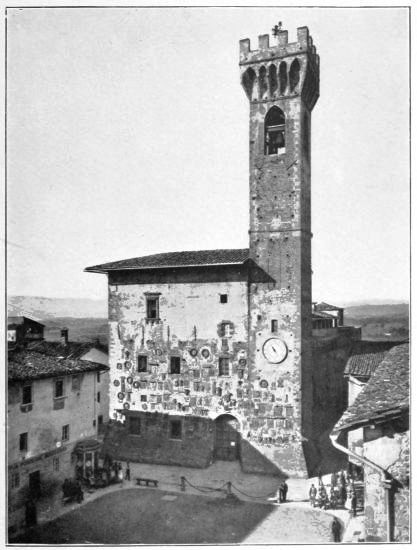
Alinari
PALAZZO PUBBLICO, SCARPERIA
After judicious bargaining at the station with drivers of a varied assortment of country vehicles, we are cleverly packed into two small, rattling, rather clumsy but very comfortable carts, one drawn by a phenomenally brisk donkey, and away we bowl toward the towers of Scarperia. Somehow the sunshine and exhilarating air incites us into rebellion against Mr. Ruskin's opinion that the scene is "only a grey extent of mountain ground, tufted irregularly with ilex and olive, a scene not sublime, for its forms are subdued and low; not desolate, for its valleys are full of sown fields and tended pastures; not rich nor lovely, but sunburnt and sorrowful."
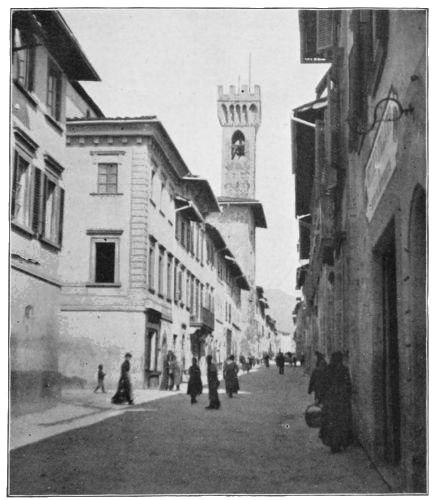
M. M. Newell
THE MAIN STREET, SCARPERIA
For us a golden touch is laid on everything; we love the plain of olive orchards and vineyards and peaceful fields; the large, white, violet-eyed Tuscan oxen driven by kindly faced peasants; even the donkey is a nonesuch, and we wax poetic over the greenest of green patches of grain in vineyards, the rows of lopped elm-trees married to the vines, which are festooned from trunk to trunk. Along the way we meet the country doctor, riding madly in his cart drawn by a[14] quick-stepping pony. Another Dr. Antonio, we say, ready in case of accident to invent and furnish us anything from bathing-machines and coffee-pots, instruction in botany and art, to a serenade, or making butter to accompany the good bread of Scarperia, unbaked loaves of which we see carried into the town on a long board over a man's shoulder.
But now we are rattling up the main street of Scarperia, the donkey trying his best to get ahead, and it is high time to speak like a guide-book, though no account we have found condescends to give the population of the place, which is the way every well-regulated book should begin. Murray's description is summed up in half a dozen lines, as follows: "Scarperia was built in 1306 by the Commune of Florence to curb the pride of the Ubaldini and other rebels of the Mugello. The parish church has some fine cloisters. In the Palazzo Vecchio there are interesting frescoes. There is a large industry of scissors." This is all.
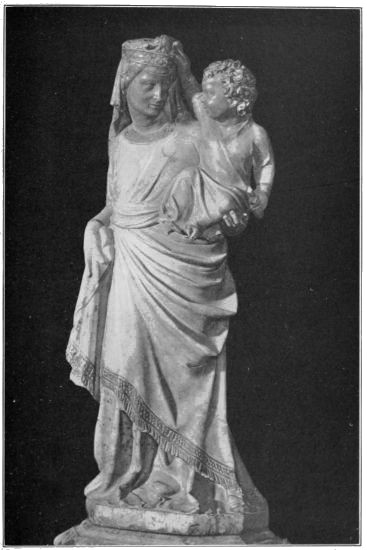
Alinari Giovanni Pisano
MADONNA AND CHILD OF THE SACRED GIRDLE
DUOMO, PRATO
We hasten to buy scissors, also the ubiquitous postal card, visit the cloisters, which are really good, and then hang about the old Palazzo, which would alone make the town interesting. Its tower, or campanile, is remarkably fine, simpler and a thought more serious, perhaps, but hardly less beautiful, than its more famous sister of the Palazzo Vecchio, Florence; and the good[17] people of Scarperia proudly declare that it was at least designed by the same master hand—that of Arnolfo di Cambio. It rises gracefully as a lily on its grey stalk, dominating the clustering red roofs below and peering at us over the cloister roof, as if to say, "We belonged together in those stirring mediæval days when municipal life had two centres: the Palazzo Pubblico and the Duomo—Civil Government and the Church." The façade of the old palace is a mad eruption of various coats of arms, or stemmi, carved in stone or formed in reliefs of glazed terra-cotta, and no less than fourteen of these are products of the Della Robbia atelier, bearing the devices of great families of Tuscany; and here, if we were wise in heraldry, might the whole history of the Mugello be set forth as it transpired in those adventurous days before its rebels had been curbed! Prominent and oft-repeated among these stemmi is the Medici shield emblazoned with its balls, or pills, suggesting the traditional origin of that famous house and proud device. The story runs that, when Charlemagne made his historic descent upon Italy, among his followers was a certain brave and noble knight named Avérard Medici, who, amid the Apennines, encountered and challenged to mortal combat a mighty giant called Mugello, who ruled with a high and cruel hand all this[18] portion of Italy. After a long and furious battle the giant was done to death, and Avérard, as victor, took possession, not only of his arms and personal goods, but all the lands under his sway—that is, the territory bearing his name to this day. What is more, the six dents on Avérard's golden buckler, which had been made by the furious blows of Mugello's iron-spiked club, became the Medici device. There is historical evidence that an early Medici settled in this region and possessed great estates and castles, to which he very shrewdly retired whenever his enemies in Florence became too troublesome. There is also proof that while Cosimo, "father of his country," beautified Florence with noble villas, palaces, and churches, he did not neglect the cradle of his race, but built in the Mugello the two convents of the Bosco and of St. Francis.
We enter the old palace through a stately atrium, or vestibule; the walls are covered with coats of arms and faded frescoes, and beyond is a pleasant little court open to the sky, but serving the municipality to-day no further than as a chicken enclosure. Then we ascend the broad stone stairway to the municipal offices; the faded frescoes of Our Lady and saints in the anteroom are doubtless good, and deserve more attention than we give them; but our eyes are enthralled by the superb view from the[19] window of the river-laced plain and encircling mountains.
After lunch at the modest albergo, where kindly faces and willing service more than compensate for an indifferent cuisine, we set forth for a long drive of exploration through the Mugello. Our carriage, "the calash," is apparently an institution of Scarperia, and is such a pleasant surprise that we heartily commend it to all fellow travellers. It is a rather light, well-hung, smart-looking vehicle, something between a victoria and landau in shape, with comfortable seats which easily accommodate our party of five. It is drawn by a pair of glossy chestnut roadsters unvexed by checking-straps or throat-chains, and stepping off freely at a brisk, even trot, which they maintain steadily during the entire drive of thirty miles. Our handsome young driver is in keeping with his equipage—kind and skilful with his horses, and courteous in answering our many questions. Thus we drive all the sunny afternoon through the fertile and well-tilled valley, over the best of roads, passing comfortable farm-houses, orchards, and vineyards, where the peasants are busy trimming and tying the vines or turning the earth with awkward, primitive spades. We cross and recross the river Sieve over picturesque stone bridges half hidden[20] by birches and elms.

ANCIENT CAMPANILE DELLA PIEVE BORGO S. LORENZO
Our first halt is at Borgo San Lorenzo, chief town, or capital, of the Mugello, situated on the Sieve, also on the direct railway line to Faenza, and containing about three thousand inhabitants. While lacking, one cannot tell why, the charm of Scarperia, the town has its attractions, notably two noble and well-preserved gateways, several towers, and many a cluster of rich-coloured, irregular roofs. Especially interesting is the lofty Antico Campanile della Pieve—a battered veteran keeping its time-honoured watch and ward over the Sieve valley, its sides showing many a scar and patch,[21] and its simple, conical roof, like an old cap pulled low over its sleepless eyes.
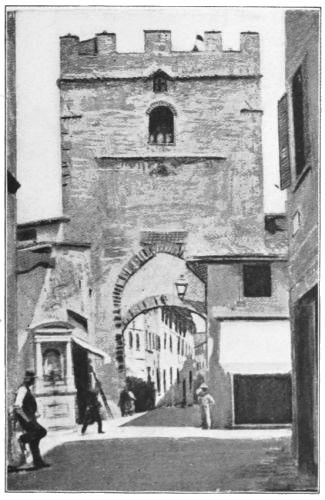
TORRACCIA ROMANELLI, BORGO S. LORENZO
We enter the town through the fifteenth century gateway, its battered watch-tower speaking volumes of that olden time when Mugello's rebels worked their stark will along these narrow thoroughfares. The substantial, old Palazzo del Podestà, minus a tower, looks somewhat meekly forth on its ancient square, or piazza, as it has done for centuries. Its façade is hung thick with the shields of turbulent lords, ten of whom called on the Della Robbia art to set forth their emblems here, also to fashion glazed terra-cotta Madonnas for the churches of St. Catherine and St. Stephen, hard by.

A FARM-HOUSE, MUGELLO

PONTE D'ELSA, MUGELLO
We can stop but a few moments at Borgo San Lorenzo, and soon drive on, past a little shrine at the street corner and under the battlemented tower called Torraccia Romanelli, to our country roads once more. Outside the walls the country assumes a more broken and hilly appearance, fewer cultivated fields, and more pasture where a few sheep graze; irregular farm-houses[23] of rough, grey stone, with loggias and sloping roofs of red tiles, set amidst scattering trees, many of them cypress, dark and rusty as an outworn mourning coat. The accompanying picture shows a representative house of the country, and we are told that this one had its little romance and love's young dream. It is a wrinkled old woman you see trudging down the hillside to fill her copper bucket at the stream; but in yonder corner loggia is a sparkling-eyed young contadina, some pretty Tessa, who as she spins her flax is thinking of[24] a handsome and dashing young Florentine who often finds his way to the farm-house, which belongs to his uncle's country villa hard by. A bit farther on we reach the pretty double-arched bridge Ponte d'Elsa, the very one, our driver says, where Cimabue met the shepherd boy Giotto; and here too, nibbling the scanty[25] grass along the roadside, are surely the descendants of Giotto's sheep, even the new-born lamb looking quite mediæval.
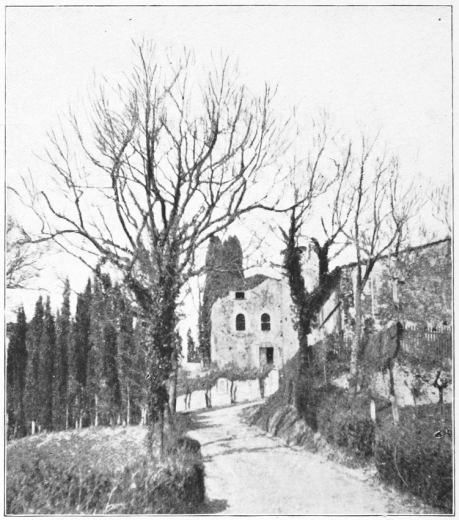
M. M. Newell
HILL OF VESPIGNANO, MUCELLO
The hill of Vespignano, Giotto's birthplace, is much too steep for the chestnuts and calash; moreover, we are only too glad of an excuse for walking up the pretty path cut into the hillside, bordered by trees hung with ivy, and leading to a serried rank of young cypresses, ranged together like a black watch on the crest of the hill, as if to guard the modest stone building, which tradition says is the very house where the artist Giotto was born. Even for a shepherd's dwelling, the house is small and uninteresting, which naturally flings a suspicion over its verity; nevertheless, the spirit which actuates the preservation of all historical sites and relics by the Italian government cannot be too highly commended. The house is converted into a meagre museum, and kept in good order on estates at present belonging to the Villa Capriani-Cateni, the various buildings of which cover the crest of a considerable height and possess a noble outlook into the near hills, which are now taking on a hazy blue mystery in the afternoon light. A large portion of the villa is of modern architecture, plain and dignified, but the massive, square battlemented tower at one corner is of quite an early date, perhaps the thirteenth century, while[26] not far away is the ruined prison-house of ruddy grey stones and brickwork, with a picturesque round tower, presumably of a still earlier time, and reminding one of the ancient towers still found in parts of Ireland. The whole pile speaks eloquently of a long residence on this hilltop of a people whose wants were few,[27] their tastes stern and simple as the mighty Apennines which encircled them. A fine-looking old man is weaving an osier basket as he sits on the terrace in the shadow of the old tower. He answers all our questions with quiet courtesy; but upon our offering him a fee, as we have learned is generally expected, it is gently but firmly declined, and we walk away somewhat abashed, thinking of the varied influences which surrounded young Giotto amid such pastoral scenes and such kindly, self-respecting people. He certainly must have carried much of the experience and knowledge of his shepherd life into his art.
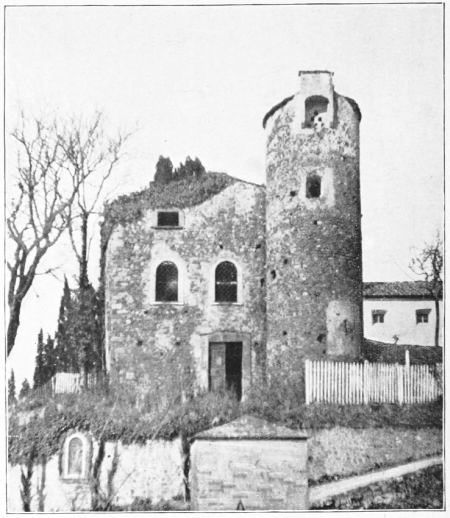
M. M. Newell
ROUND TOWER, VESPIGNANO
In the Arena Chapel, Padua, one of the finest of the frescoes is that of Joachim returning to the sheepfold, where Giotto shows his intimate knowledge of a shepherd's surroundings and animal forms, but particularly of the characteristics of sheep, giving to each one an individuality which only a close observer could have done. There is the same quality in one of the sculptures on his tower in Florence, where the puppy, with an absurd expression of anxious responsibility, is guarding the sheep.
As the shadows lengthen and the mountains are gleaming in purple and gold, we return to Scarperia for the night, and enjoy such sleep in the clean, coarse,[28] homespun linen on our beds, as only a day in the brisk open air can give.
The morrow is Sunday, and the old Piazza, between church and palace, is filled with the people coming and going to mass, and to chaffer with the pedlar displaying his wares on a little cart, consisting of a slender stock of kerchiefs, stuffs, bright toys, and various homely utensils, which he cries as lustily as another Autolycus:
Both men and women have good faces, with that kindly responsive and patient expression characteristic of the Italian peasants; they are interested in everything, particularly in the forestieri, who in their turn enjoy the groups of women and children in gay kerchiefs and gowns, making a pretty picture in the old grey square. We walk through the narrow streets, sit on the city walls which still partially surround the town, and look down on the pretty road overhung with trees, where the trailing-footed, white oxen slowly come and go, placid and restful.
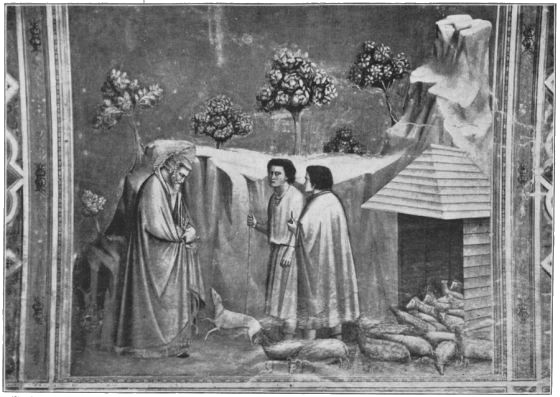
Alinari Giotto
JOACHIM RETURNING TO THE SHEEPFOLD, ARENA CHAPEL, PADUA
We follow the contadini out of the old city gate[31] on the road to St. Agatha's Church, lying between vineyards where the young grain is now pushing its green spears through the brown earth—for spring is later here than in Val d'Arno—and olive orchards, where clouds of silver-grey leaves quiver and shine in the light.

M. M. Newell.
FROM THE WALLS OF SCARPERIA

M. M. Newell
A COUNTRY ROAD, SCARPERIA
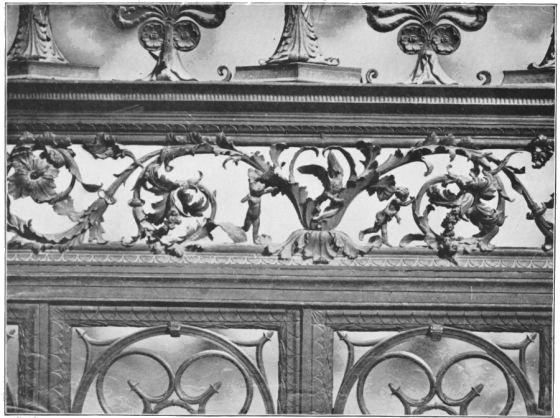
Alinari
DETAIL OF THE GRILLE
CHAPEL OF THE SACRED GIRDLE, CATHEDRAL, PRATO
Taking another road, we saunter on a mile or so to the Villa Tolomei, belonging to an old Tuscan family, whose arms are a gold band with three green vine leaves on a blue field, and above a red label with the three gold lilies of Anjou. The grounds are pleasant, though somewhat neglected, but the prospect looking[35] toward the mountains is entrancing; and the walk back toward Scarperia gives us a continual view of the fine campanile. By this time all the rebel blood of the Mugello is burning in our veins, and we demand a drive back to Florence; no railroads and tunnels for us if we must leave these "dear country places." We long to push eastward, only three paltry miles away, up to the very crests of the Apennines, where all the rivers hasten joyfully to the Adriatic. But not to-day may we follow fancy's lead eastward along curving Ronco's flowing stream, but again, with chestnuts and calash, are constrained to hold our way along the river bank, returning over the road to Piero a Sieve—was it only yesterday that we first knew it?—and strike at once into the famous old highway leading from Bologna to Florence, as it has done almost since the beginning of the Christian era. What a thoroughfare it has been! What mighty personages have trod this path with high hopes, burning spirits, and breaking hearts!
What hordes of barbarians and armies of haughty kings have swept this way; what great pageants and devout pilgrimages! We remember that one of Gian[36] Galeazzo, Duke of Milan in 1471, when, accompanied by his wife, Bona of Savoy, in accomplishment of a vow, he made a pilgrimage to Florence in unparalleled splendour. There were twelve palanquins of cloth of gold borne on the backs of mules over the Apennines, preceded by fifty palfreys for the Duchess and her ladies when they preferred the saddle; fifty horses for the Duke and his gentlemen; five hundred foot-soldiers, one hundred mounted men-at-arms; fifty body-servants in livery of silk and silver, fifty huntsmen holding dogs in leash, fifty with falcon on wrist, each bird valued at two hundred golden florins, etc., etc. With all this pomp the train descended into the Val d'Arno, proceeded to Florence, and were received at the Medici palace in Via Larga, now the Cavour. When we reach Vaglia, again we struggle with the temptation to turn aside for the delightful walk of five miles to Bivigliano and find the Della Robbia Madonna and Saints (from the atelier) at the parish church of St. Romola, thence a mile farther to the foot of Monte Senario, 2,700 feet high, which overlooks us all the way. But we hold to our course, and after a few miles and a stiff walk of half an hour we mount to Pratolino, 1,512 feet, the highest point we touch, lying just below Monte Senario, and commanding an extensive view on every side. Near the village is the celebrated Villa of Pratolino, built originally in 1570 by Duke Francesco de' Medici for the reception of his wife, the beautiful and notorious Bianca Cappello. It was surrounded by noble gardens and terraces, and because of its superb situation became the favorite residence of the luxury-loving Duchess. The property is now owned by the Prince Demidoff, but nothing remains of the original villa except a colossal crouching figure, personifying the Apennines, which is ascribed to John of Bologna.

Alinari Alessandro Allori
PORTRAIT OF BIANCA CAPPELLO
UFFIZI, FLORENCE
Our Mugello excursion is over; we are slipping[39] through the Mugnone and down into Val d'Arno. First Fiesole welcomes us; then the dear, familiar towers of Florence, the fairest city in the world; only a poet can convey the charm of this exquisite scene. "Few travellers can forget," says Mr. Ruskin, "the peculiar landscape of this district of the Apennines. As they ascend the hill which rises from Florence to the lowest peak in the ridge of Fiesole they pass continually beneath the walls of villas bright in perfect luxury and beside cypress hedges inclosing fair terraced gardens, where masses of oleander and magnolia, motionless as leaves in a picture, inlay alternately upon the blue sky their branching lightness of pale-rose color and deep-green breadth of shade, studded with walls of gleaming silver; and shining at intervals through[40] the framework of rich leaf and rubied flower the far-away bends of the Arno beneath its slopes of olive, and the purple peaks of the Carrara mountains tossing themselves against the western distance, where the streak of motionless clouds hover over the Pisan sea."

UBALDINI
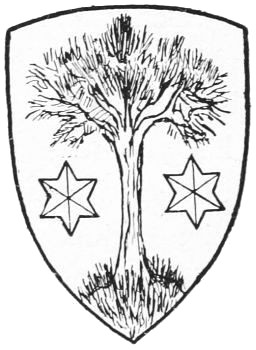
VICCHIO

Alinari Benozzo Gozzoli
THE PROCESSION OF THE MAGI
CHAPEL OF THE RICCARDI PALACE, FLORENCE

 HRICE had we been in Florence
and never seen Prato, only twelve miles away. Many times had we
noted in passing where the waters of her little river, the Bisenzio,
join the Arno, and wished to follow its banks through the plain to
the city whose fortunes and history are so identified with those of
Florence. There was no good reason for not going to Prato; there are
several ways of doing it—by diligence, tram, or steam; and
Murray declares that half a day will suffice to see the town. So one
hot day we took the plunge, boarded the tram, first having provided a
bountiful luncheon, for of course the inns would be impossible. We can
not recommend that tram ride. The line passes through a flat, dusty
country, the service is unpardonably slow and tedious, and we were
smothered in dust and very cross. But let us hasten to say that the
journey itself was our only[46]
disappointment; all discomfort vanished with our arrival. We were
charmed with our first glimpse of the city, and found the Albergo
Giardino so good that we were obliged to apologize for bringing a
luncheon and supplement it generously from the hotel menu. Temper
restored and at peace with all the world, we set forth to prove Herr
Baedeker's statement that a visit to Prato is "indispensable to those
who desire to acquaint themselves thoroughly with the early Renaissance
style of Florence;" for which same thorough acquaintance we had allowed
ourselves four hours, forsooth! The Prato of to-day has, of course,
its praiseworthy modern enterprise and industries: the women are
picturesquely busy at every street corner with straw plaiting,[47]
there is a good trade in woolen cloths, and the
bright red caps (calabarsi), made here are greatly demanded
in the Levant; in side streets we come upon
shops hung with gleaming copper vessels of every
sort and shape, and the sound of the coppersmith's
hammer rings out merrily on the clear air. It is
said that the people have a reputation for rudeness
and turbulence, but what can you expect from a
town which, having made the good fight for freedom,
lost its independence and its identity in that of another
city, that was once captured by the redoubtable
Castruccio, and, to crown all disaster, was from 1512,
for twenty-two years, made to suffer all the atrocities
that Spanish cruelty could devise? After all, the City
of the Meadow (prato) is in no sense a modern town;
its ancient walls are still intact; the castle, if fallen
from its high estate as a citadel, is still a delight to all
the snap-shotting fraternity; and if the streets are no
longer gay with ruffling bravos in their fine attire, the
ancient palaces of the Commune and Pretorio still hold
their own in point of noble architecture and as venerable
centres of justice and good government.
HRICE had we been in Florence
and never seen Prato, only twelve miles away. Many times had we
noted in passing where the waters of her little river, the Bisenzio,
join the Arno, and wished to follow its banks through the plain to
the city whose fortunes and history are so identified with those of
Florence. There was no good reason for not going to Prato; there are
several ways of doing it—by diligence, tram, or steam; and
Murray declares that half a day will suffice to see the town. So one
hot day we took the plunge, boarded the tram, first having provided a
bountiful luncheon, for of course the inns would be impossible. We can
not recommend that tram ride. The line passes through a flat, dusty
country, the service is unpardonably slow and tedious, and we were
smothered in dust and very cross. But let us hasten to say that the
journey itself was our only[46]
disappointment; all discomfort vanished with our arrival. We were
charmed with our first glimpse of the city, and found the Albergo
Giardino so good that we were obliged to apologize for bringing a
luncheon and supplement it generously from the hotel menu. Temper
restored and at peace with all the world, we set forth to prove Herr
Baedeker's statement that a visit to Prato is "indispensable to those
who desire to acquaint themselves thoroughly with the early Renaissance
style of Florence;" for which same thorough acquaintance we had allowed
ourselves four hours, forsooth! The Prato of to-day has, of course,
its praiseworthy modern enterprise and industries: the women are
picturesquely busy at every street corner with straw plaiting,[47]
there is a good trade in woolen cloths, and the
bright red caps (calabarsi), made here are greatly demanded
in the Levant; in side streets we come upon
shops hung with gleaming copper vessels of every
sort and shape, and the sound of the coppersmith's
hammer rings out merrily on the clear air. It is
said that the people have a reputation for rudeness
and turbulence, but what can you expect from a
town which, having made the good fight for freedom,
lost its independence and its identity in that of another
city, that was once captured by the redoubtable
Castruccio, and, to crown all disaster, was from 1512,
for twenty-two years, made to suffer all the atrocities
that Spanish cruelty could devise? After all, the City
of the Meadow (prato) is in no sense a modern town;
its ancient walls are still intact; the castle, if fallen
from its high estate as a citadel, is still a delight to all
the snap-shotting fraternity; and if the streets are no
longer gay with ruffling bravos in their fine attire, the
ancient palaces of the Commune and Pretorio still hold
their own in point of noble architecture and as venerable
centres of justice and good government.

Alinari Benozzo Gozzoli
DETAIL OF THE PROCESSION OF THE MAGI
CHAPEL OF THE RICCARDI PALACE, FLORENCE

M. M. Newell
ARCADES WHERE HANG THE COPPER AND WOOLEN GOODS
Very different, indeed, must it have been in the fourteenth and fifteenth centuries, when Prato was in the zenith of her wealth and pride, when Donatello and Fra Lippo Lippi, Mino da Fiesole, and the Pisani were busy there, and all the world was running to see their work; crowned heads and critics, humble aspirants and cavalcades of brilliantly attired Florentines were arriving daily to admire and criticize the new art. The jaded tourist of to-day, if a true lover of nature and history, thinks yearningly of the mediæval journeyings over these roads; of the humble enthusiast making his way on foot, and of gay trains of mounted nobles riding leisurely through these regions of delight. Benozzo Gozzoli has[51] shown us how it was done in his noble fresco "Procession of the Magi," painted on the walls of the Riccardi Palace to commemorate the visit of the Eastern Emperor, John Palæologos, in 1439, who, according to an inscription in the Duomo of Prato, made an excursion thither from Florence accompanied by the illustrious Bessarion and a suite of six hundred cavaliers magnificently appointed. The "three kings" in the fresco are represented by the Emperor, the patriarch Joseph, and the young Lorenzo de' Medici, who are surrounded[52] by theologians and scribes, attended by a train of cardinals, bishops, and nobles, with their servants and horses, in splendid array. The painted scene is full of the vigour and freshness of spring—of that spring when men awoke to the force and meaning of human existence, "freedom of thought, beauty of the world, and goodness of youth and strength and love and life." Those gay young cavaliers prancing over the plain, exuberant with their new joy in nature, colour, and splendour of dress, are equally keen in their intellectual freshness; every man is a poet, Lorenzo de' Medici himself the "most typical poet of his century," and their every verse rings with the burden, "Gather ye rosebuds while ye may."

M. M. Newell
THE FORTRESS
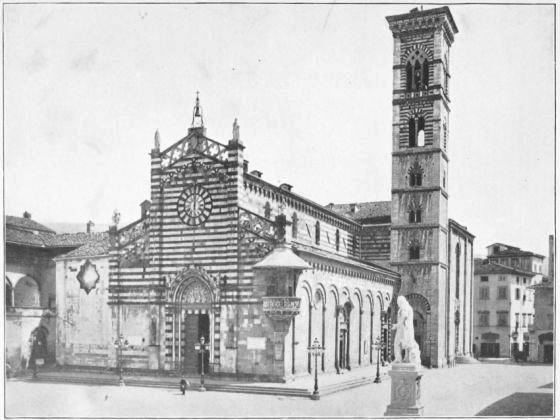
Alinari
THE CATHEDRAL OF PRATO
Like Benozzo Gozzoli's train, we would sweep gaily from the court of the old Medicean palace into Via[55] Larga, pass through the Piazza del Duomo, invoking the protection of Santa Maria del Fiore, cross the ample square of Santa Maria Novella, and so come to Porta al Prato, leading out to the plain, blue at this time of the year with the small Tuscan lily which gave Florence her device. Then, as now, we would pass through a busy suburb, or borgo, clustering about the gate, and take our way over the plain, thick set with little hamlets, vineyards, and orchards, and having always at our right hand the fair Tuscan hills, hung with blooming gardens and starred with shining villas. There is many a shrine or church along the way well worth a brief halt, and such a leisurely ride may easily include a short visit and refreshment at many of the Medici villas in the vicinity—at Careggi, finest of them all, first occupied by Cosimo, Pater Patriæ, rebuilt by Michelozzo, and where Lorenzo would, at a later day, gather about him the scholars, artists, and singers of that rich time; here also tradition places that improbable scene between Savonarola and Lorenzo at the time of his death. The grand old tower of Petraia next lifts its crown above a bosky hillside; this villa, now the Royal Villa, was the work of Brunelleschi, and may well be visited for the sake of its noble gardens and rare trees—among them an oak four hundred years old. It is said that Poggio a Cai[56]ano, somewhat farther on, was Lorenzo's favorite villa; earlier it belonged to the notorious Pistojese family, the Cancellieri, who boasted among their members eighteen knights with golden spurs, and whose quarrels originated the widespread feuds of the Bianchi and Neri. Lorenzo loved the place, and called his favorite[57] architect, Giuliano Giamberti, whom he had fondly nicknamed "San Gallo," to build his villa; the plain exterior is broken only by a fine classic portico, while the pride of the villa is the great hall with its beautiful barrel roof—a creation which Lorenzo had declared San Gallo could never accomplish. Later this architect built the little church of the Madonna delle Carceri[1] at Prato—"perhaps," says our critic, "the gem of the Laurentian age of architecture," and certainly "classical principles have never been employed with more sympathy and more originality."

M. M. Newell
GARDEN BELONGING TO THE ROYAL VILLA OF PETRAIA

Alinari Donatello
EXTERNAL PULPIT, CATHEDRAL, PRATO
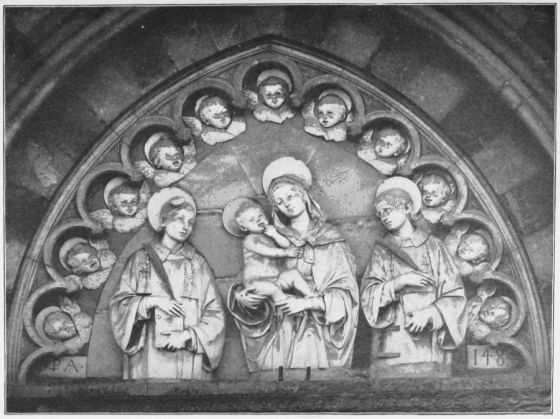
Alinari Andrea della Robbia, 1489
MADONNA AND CHILD, WITH SAINTS
LUNETTE OVER CENTRAL DOOR OF THE DUOMO, PRATO
Thus filling a memorable day, we should come at
eventide, as the setting sun sifts its gold on olive-clad
hills, to Prato on the Bisenzio, where even an emperor
might study with interest the civilization of the West
during the "age of the despots," and its reawakening in
learning and art. He would also enjoy the hospitality,
for which the city was noted when Florentine nobles
made Prato their frequent residence and enriched their
palaces there with every form of art and luxury, for
which that time was celebrated. Prato, we find, has her
tradition honouring her above all other cities in the
world, and about which centres much of her importance[60]
in art. The story runs something like this: When the
Blessed Virgin disappeared from earth, it seems that
St. Thomas, father of skeptics, could not believe that
she had been caught up into heaven, as everybody
knows who looks at Italian paintings. The Virgin, to
convince him, dropped from the clouds her girdle (cintola),
which St. Thomas faithfully cherished while he
lived. After his death the holy relic descended in course
of time to a Greek priest. All this happened in the
Holy Land, to which, in 1096, journeyed a certain
Michael of Prato, who, being an Italian, was presumably
a handsome man with a silver tongue, won
the love of the aforesaid Greek priest's daughter,
who brought the sacra cintola as part of her dowry.
Michael returned with his bride to Prato, where they
lived the rest of their lives, and treasured the precious
relic with the greatest reverence and care. Eventually
it was transferred to the cathedral, where it is kept
in a chest sculptured by Giovanni Pisano, and the
keys thereof jealously guarded by the Bishop of the
Diocese and worshipful Syndic of the City of Prato.
The people hold the relic in the profoundest reverence;
five times during the year it is, with great ceremony,
publicly exhibited, until about the tradition has gathered
a religious cult, to which many of the noblest works
of art in the Duomo directly refer. The Duomo alone
[63]
stands for seven centuries of art (though little remains
of the earliest church, built in the eighth century), and,
like its noble campanile, is the work of Giovanni
Pisano. It is built of alternate bands of fine limestone
and the dark green serpentine from neighboring Monte
Ferrato.[2] On the northwest corner of the church is
the external pulpit of Donatello, "Prince of Humanists,"
supported by Michelozzo's bronze capital. The
pulpit is adorned with seven reliefs of dancing figures,
"half-childish and half-mythical," with musical instruments.
From this pulpit, if it chance to be May Day
or Easter, we may witness the picturesque ceremony
of exhibiting the sacra cintola to the devout people in
gala dress, kneeling in the piazza below. We enter
the Duomo under Andrea della Robbia's lunette of the
Madonna and Child, attended by St. Stephen and St.
Laurence, the whole surrounded by a wreath of cherubs'
heads; this relief, among the many Della Robbias in
various churches and oratories of Prato, is the only one
executed by Andrea's hand, and is a beautiful and
serious work in the master's late manner. The interior
of the church is in the form of a Latin cross, its roof[64]
supported by columns of serpentine; at the left is the
chapel of the Sacra Cintola, surrounded by a fine
bronze grille or screen, wrought by Bruno di Ser Lapo
at Lorenzo's order. It is a masterpiece of graceful designs,
circles, quatrefoils, wreaths, and acanthus leaves,
among which appear tiny figures of cherubs supporting
the arms of Prato—a shield powdered with the lilies of
Anjou. Over the screen hang thirteen silver lamps
of antique form, kept ever alight before the altar,
where stands the charming Madonna by Giovanni
Pisano and the sculptured ark or chest containing the
sacred girdle. On the walls is Angelo Gaddi's painted
story of the life and death of the Virgin and the gift of
her girdle to St. Thomas. The same subject, splendidly
painted by Ridolfo Ghirlandaio, hangs over the great
west door. In the nave, amid all this richness of
colour, Mino da Fiesole's beautiful marble pulpit shines
out with its delicately sculptured reliefs, supported on
serpent-tailed sphinxes. Foremost, however, among the
treasures of the Duomo, are Fra Lippo Lippi's frescoes
in the choir, considered his most important work.
Nothing, perhaps, puts one so fully in touch with
fifteenth-century men and art as the career of this
vigorous and prolific artist, a true son of the Renaissance,
who, while he paints sweet-faced Madonnas,
dimpled children, and holy saints on monastery walls,[65]
follows his own pleasures and trolls out his careless
love song:

Braun, Clement et Cie. Botticelli
LUCREZIA TORNABUONI, WIFE OF LORENZO IL MAGNIFICO
WEARING THE MARSYAS JEWEL OF THE MEDICI
Song
Our allotted "four hours" for Prato have come to an end, leaving many beautiful things unseen; the pleasant cloisters of San Francesco, the perfect Renaissance church of Santa Maria delle Carceri, and many others, must be left to that indefinite "next time." We hasten to the train, stopping only a moment at the shrine on the corner of Via S. Margherita, which contains Filippino Lippi's Madonna, where we murmur our thanks for a happy visit and make solemn vows to come soon again.

STEMMA, PRATO

Alinari A. della Robbia
DETAIL OF FRIEZE
S. MARIA DELLE CARCERI, PRATO
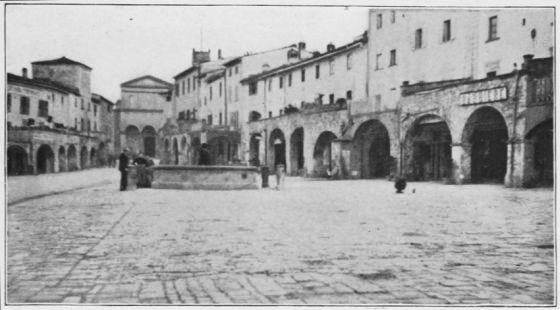
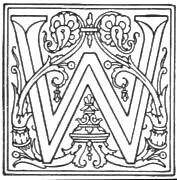 E made our first home in Florence
with our good friend Signora V—— and her daughter. Our
rooms were on the second piano, which meant three flights of
uncompromising stone stairs, but once at the top our windows overlooked
the piazza on one side, a pretty garden on the other, and gave us
plenty of sunshine; moreover, we had a loggia, a very different matter
from a balcony or gallery both in name and character, and from which
we got charming views of the distant hills. Within was every creature
comfort—not luxury, perhaps, but[74]
cleanliness, order, refinement, and an excellent table
with two servants, merry-faced Dina and kindly Annunziatina,
to serve and pet us, to identify our wants
and interests as their most pleasurable duty, and teach
us to say that Tuscan cookery and Tuscan servants, at
their best, cannot be equaled the world over. The relation
between the Italian family and servants is in
many cases almost ideal: there is complete understanding
and freedom of speech; the mistress talks and consults
with the maid, and she, in turn, depends on her
mistress as on a mother, and yet neither forgets her
place or dignity. As for food, where will one find such
sweet, tender vegetables, such crisp salads, and macaroni
served in a dozen different ways, each better than
the other? For the first month every dish brought to
the table was a mystery and delightful surprise. How
could one have lived half a century and never known
fritto misto, or the changes that may be rung on rice
or corn meal? What a far different object the pomidoro
is in Tuscany from the tomato of commerce in
Boston! Then, who ever can measure the capacities of
chestnuts? As for meats, if variety is limited, certainly
the methods of cooking are legion, and one
never seems cloyed with the Tuscan chicken; oil
and cheese are delicious. For tea Italians care nothing,
and their coffee leaves much to be desired; but
who would drink either, or even the questionable water
of Val d'Arno, when pure wine may be had for the
asking? Tuscan wine certainly "needs no bush," but
there are so many degrees, even of the boasted Chianti,
that only the wise may be sure of the best. At our
signora's we had the most delicious wine, both white
and red, and, mark you, without extra charge. "It is
Chianti," she said, when we asked its name. "But,"
we urged, "all the wine of Tuscany is Chianti, non è
vero?" "Quite the contrary," was her answer, "it is
only produced in a certain limited region on the hillsides
of Chianti; we must take you some day to our
vineyard in the true Chianti hills, where this wine was
made." That happy day came in April, when the Tuscan
spring was in its fullest bloom. We took a steam
tram at the Porta Romano, which, as its name indicates,
opens on the old Roman road to Siena, and at
once began our climb into the hill country. Three miles
from the gate, where the little rivers Ema and Greve
join, we passed near the Certosa, more like a fortress
than a monastery, seated so imposingly on its lofty
hill; then our road led along the banks of the Greve
till we reach the village of the same name, which is the
chief town of the Chianti region. It was a beautiful
ride, trending southeastward, and by many a turn and
loop, affording views of glens, valleys, and hills, grey
stone bridges, castles, villas, and churches. At Greve
a carriage was waiting for those who wished to ride;
others preferred the steep, breezy walk over the hills
that separate Greve from Val di Pesa, from which we
saw Florence in her Val d'Arno, twenty miles away.
All along the road were ruins of ancient castles and
piers of bridges, which once defined the marches between
Siena and Florence, held only by constant war-fare;
but now the crumbling towers keep watch and
ward over peaceful olive groves and unmolested vineyards.
E made our first home in Florence
with our good friend Signora V—— and her daughter. Our
rooms were on the second piano, which meant three flights of
uncompromising stone stairs, but once at the top our windows overlooked
the piazza on one side, a pretty garden on the other, and gave us
plenty of sunshine; moreover, we had a loggia, a very different matter
from a balcony or gallery both in name and character, and from which
we got charming views of the distant hills. Within was every creature
comfort—not luxury, perhaps, but[74]
cleanliness, order, refinement, and an excellent table
with two servants, merry-faced Dina and kindly Annunziatina,
to serve and pet us, to identify our wants
and interests as their most pleasurable duty, and teach
us to say that Tuscan cookery and Tuscan servants, at
their best, cannot be equaled the world over. The relation
between the Italian family and servants is in
many cases almost ideal: there is complete understanding
and freedom of speech; the mistress talks and consults
with the maid, and she, in turn, depends on her
mistress as on a mother, and yet neither forgets her
place or dignity. As for food, where will one find such
sweet, tender vegetables, such crisp salads, and macaroni
served in a dozen different ways, each better than
the other? For the first month every dish brought to
the table was a mystery and delightful surprise. How
could one have lived half a century and never known
fritto misto, or the changes that may be rung on rice
or corn meal? What a far different object the pomidoro
is in Tuscany from the tomato of commerce in
Boston! Then, who ever can measure the capacities of
chestnuts? As for meats, if variety is limited, certainly
the methods of cooking are legion, and one
never seems cloyed with the Tuscan chicken; oil
and cheese are delicious. For tea Italians care nothing,
and their coffee leaves much to be desired; but
who would drink either, or even the questionable water
of Val d'Arno, when pure wine may be had for the
asking? Tuscan wine certainly "needs no bush," but
there are so many degrees, even of the boasted Chianti,
that only the wise may be sure of the best. At our
signora's we had the most delicious wine, both white
and red, and, mark you, without extra charge. "It is
Chianti," she said, when we asked its name. "But,"
we urged, "all the wine of Tuscany is Chianti, non è
vero?" "Quite the contrary," was her answer, "it is
only produced in a certain limited region on the hillsides
of Chianti; we must take you some day to our
vineyard in the true Chianti hills, where this wine was
made." That happy day came in April, when the Tuscan
spring was in its fullest bloom. We took a steam
tram at the Porta Romano, which, as its name indicates,
opens on the old Roman road to Siena, and at
once began our climb into the hill country. Three miles
from the gate, where the little rivers Ema and Greve
join, we passed near the Certosa, more like a fortress
than a monastery, seated so imposingly on its lofty
hill; then our road led along the banks of the Greve
till we reach the village of the same name, which is the
chief town of the Chianti region. It was a beautiful
ride, trending southeastward, and by many a turn and
loop, affording views of glens, valleys, and hills, grey
stone bridges, castles, villas, and churches. At Greve
a carriage was waiting for those who wished to ride;
others preferred the steep, breezy walk over the hills
that separate Greve from Val di Pesa, from which we
saw Florence in her Val d'Arno, twenty miles away.
All along the road were ruins of ancient castles and
piers of bridges, which once defined the marches between
Siena and Florence, held only by constant war-fare;
but now the crumbling towers keep watch and
ward over peaceful olive groves and unmolested vineyards.
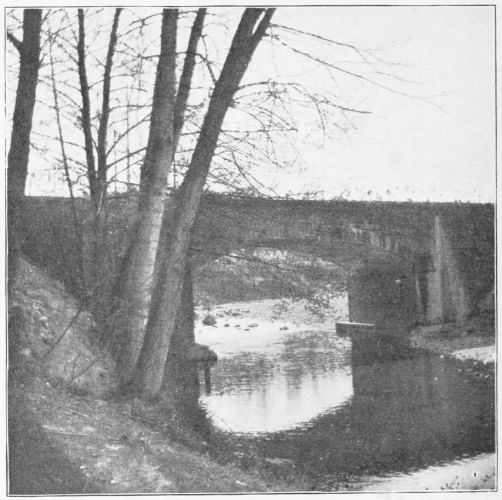
L. C. Dexter
PONTE FALCIANO, CHIANTI

L. C. Dexter
PONTE CAPELLO. ALONG THE RIVER GREVE, CHIANTI

M. S. Nixon
VITIGLIANO, CHIANTI

M. M. Newell
OLD WATCH-TOWER, CHIANTI

M. M. Newell
PANZANO FROM A DISTANCE, CHIANTI

L. C. Dexter
S. LEOLINO A FLACCIANO. PIEVE DI PANZANO, CHIANTI
Morning wears on toward midday before we get a distant view of Panzano, a warm, grey tangle of towers and red roofs, looking calm and friendly enough in the sunshine, with groves and vineyards at its feet, but once doubtless given over to the dread clamour of war. A little farther on is the parish church, Pieve di S. Leolino, with its pleasant loggia and weather-beaten bell-tower. Within are two Della Robbias, a ciborium, and a tabernacle from the atelier, and not far[81] away is the country villa, of Count Viviani della Robbia, the present representative of the illustrious family of artists.

L. C. Dexter
A VILLA IN PANZANO, CHIANTI
Thus we approach the podere, or farm, in the very midst of the Chianti district, and can easily understand the charm it has for our host, and the reason he so often puts aside his books and walks over the hills[82] from Florence to this charming spot, which has for over a century belonged in his family. "It is admirable land for the grape," we are told, "and the constituents of the soil most favourable for producing the best wine in the world, if it were only properly enriched and our methods of cultivation somewhat modernized; as it is, we must send our wine in casks to the French, who turn it into Bordeaux, and export it at very large prices." In spite of such obstacles, the fact remains that Italy is the first wine-growing country in the world, but ranks only third in wine exportation, although in the year 1902 she exported wine in casks to the value of over seven million dollars. We received a cordial welcome at our host's modest red villa, in and about which was a stir of preparation—glimpses of cheery faces and savoury odours escaping from the kitchen, all indicative of a festa. We were urged to taste delicious home-made cordial, and to admire our host's two treasures—the chair in which Garibaldi sat when he visited the villa, and an interesting wine-jar, or amphora, of elegant shape, with a decorated band and the Medici shield, bearing the seven palle, also an inscription. We then walked about the podere, or farm, through which runs the Roman road, and would have made advances to the noble white Tuscan watch-dog had we not been warned of danger. We visited the[83] substantial grey stone house of the contadino, or farmer, hard by the villa, where it has sheltered members of the same family for generations; the grandmother, evidently mistress of the establishment, a fine, dignified-looking woman, welcomed us courteously, and gratified our curiosity by taking us over the house, which consisted of three rooms; she displayed, with evident pride, the spacious bedroom, where, probably, the whole family sleep; at all events, the bed alone would accommodate half a dozen children put crossways, and there were piles of blankets and linen, all spun and woven on the farm, furnishing an inexhaustible provision for additional couches. In the kitchen we saw the great kneading-trough for the pane nero (brown bread), and the domed brick oven where it is baked; and in the loggia, or porch, stretched a long table with benches on either side, capable of seating twenty-four persons, the present census of the household. The house was clean and orderly, and suggested comfort and independence. Connected with the house, at a lower level, are the stables, where the handsome white oxen live, the ample hen-houses, and places for tools, grain, hay, etc. While we were walking about the house and sheds a peasant woman, distaff in hand and a basket on her arm, came down the Roman road, and stopped to gaze with astonishment on the group of forestieri, who, in their turn, gazed with interest into her good, honest face, and begged to take a photograph.
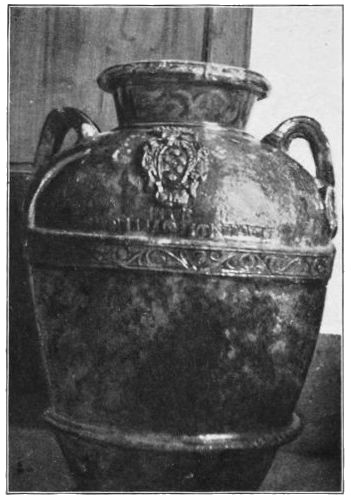
M. M. Newell
THE OLD WINE JAR. CHIANTI
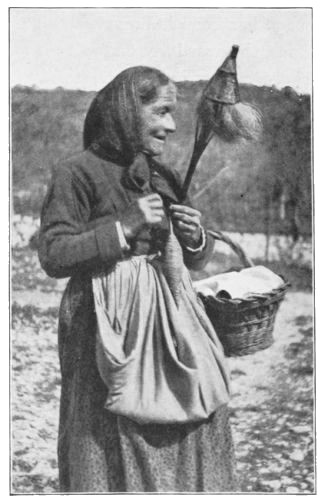
M. M. Newell
A PEASANT OF THE CHIANTI
The method of letting and working farms in Tuscany is novel and peculiarly interesting to Americans, and we urged Signor G—— to enlighten our ignorance somewhat on the subject. It seems that his estates, like the majority in Tuscany, are let on the mezzadria or metayerage system—words indicating the halving, or equal division, of products between the proprietor and his farmer.[3] The proprietor's land in Tuscany is[85] almost invariably divided into poderi (i.e., small farms of about forty acres), and each farm is tilled by a single family, who must live on the land in a comfortable house (casa colonica), furnished by the proprietor, who also provides farming tools, cattle, etc. The system is of ancient date and has come to stand as an habitual form of contract, and in Tuscany has become legalized by almost universal usage. The contract between proprietor and metayer, or farmer, holds only from year to year, but is regularly renewed, and, in most cases, the same family remains on the farm for generations. Attached to the soil they cultivate, their[86] interest is one with that of the proprietor, and they consider themselves as much owners of the land as the proprietor himself. So old is the system that language has been influenced by it; dating back to feudal times, the word contadino meant "count's man," etc. There are various understood conditions attached to the contract. The contadino must annually replant a certain number of shrubs and trees, keep roads and watercourses in order, and at Easter, Michaelmas, and Christmas supply the landlord with a fixed number of fowls and eggs. In his own house the contadino, with the title of capoccia (head), represents the family in all its dealings with the outer world: assigns tasks, decides when the vintage or harvest shall begin, apportions personal expenses, and must be consulted before his children marry; also no member of the family may marry without the consent of the proprietor, and he may even require any member of the family to marry. By the father's side stands the massaia, the wife, who superintends all housework, governs the women, assigns tasks of weaving, spinning, and mending, presides over the poultry-yard, raising of the silk-worm, etc. The mezzadria system, if not "the perfect social contract between the owner and tiller of the soil," as some claim, seems to be, in Tuscany at least, the solution of many vexed questions; it holds that labour is[87] an absolute equivalent for capital. The metayer, or contadino, works directly for his own interests, and is generally in comfortable circumstances, has a good house, excellent food and necessary implements; he is usually shrewd, knows the capabilities of his farm, is an excellent judge of an ox, and can drive a sharp bargain; he is generally sober, self-respecting, and industrious; is seldom at a loss for money on account of the diversity of his crops; he always has something to sell; his calendar is about as follows, viz.: December to March, the olive harvest; June, the cocoons; July, the wheat harvest; September, the corn; October, the vintage. The obverse side of this picture is his[88] hide-bound devotion to antiquated methods, and lack of educated intelligence; he knows nothing of the rotation of crops, the chemistry of plants and soil, or of modern implements and conveniences; he cuts his grain with a sickle and threshes it on the earth; the spade is his favourite tool, and an old Tuscan proverb runs, "The spade has a golden edge." As some one writes, Virgil's Georgics might practically be used in Tuscany as a "handbook of agriculture." Finally, the Tuscan farmer is satisfied with modest results; his average income for the year from his oil, wine, grain, vegetables, cattle, silk-worms, and straw plaiting is, approximately, three hundred dollars.
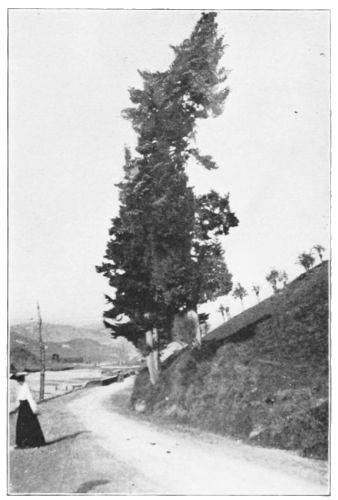
M. M. Newell
THE STATELY CYPRESS
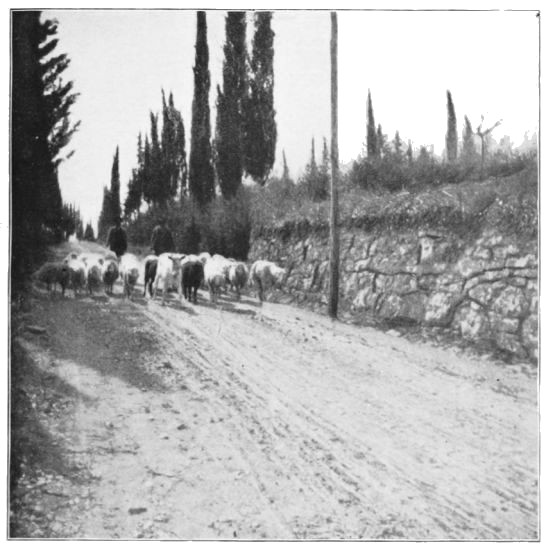
M. S. Nixon
A COUNTRY ROAD, CHIANTI
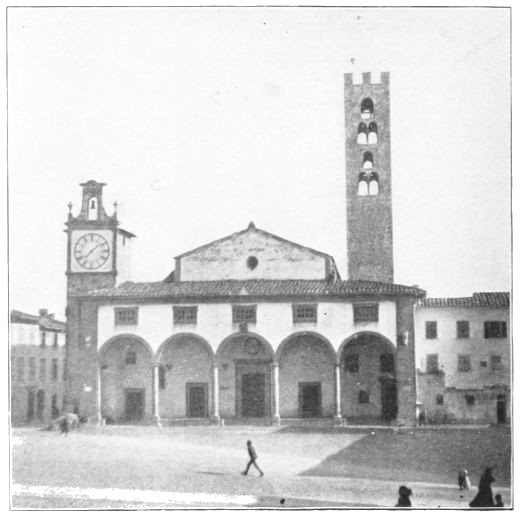
M. M. Newell
PIAZZA OF THE IMPRUNETA

M. M. Newell
A STREET IN IMPRUNETA
The call to luncheon was certainly most welcome after our morning on the hills and lesson on agriculture; as for those superior persons who proclaim that the Italian lives principally on macaroni dried on the sidewalk, black bread, garlic, and sour wine, we only wish they might have shared our feast that day in the Chianti. There was broda (soup), macaroni with pomidoro sauce, home-grown chickens and fresh salad, pane nero, sweet and warm from the oven, with the "best butter," and a delicious, fresh goat's milk cheese, served on a flat basket of plaited green rushes, to say nothing of coffee and wine without stint—some of the Chianti made twenty years before; and now[89] we know how the true Chianti ought to taste. It was a day never to be forgotten; and dreading its coming to an end, we said our reluctant good-bys to the hospitable family at Villa Rosso, and pursued our road homeward in a leisurely and roundabout way, stopping now to visit some wayside church, or tempted by[90] charming country roads leading through vineyards and lines of cypresses to some hill-crowning villa in the distance. Finally we climbed the long hill clad with olive orchards to Impruneta, where, if not too much entranced with the superb view, we may remember is the famous shrine of La Madonna dell' Impruneta, one[91] of the most important pilgrimage churches in Tuscany. The black image of the Madonna is said to have given its name to the village, but it is more probable that it is derived from the grove of stone pines crowning the hill, and is a corruption of La Pineta.[4] The tradition[92] is that this Madonna was wrought by St. Luke the Evangelist, and, having been stolen from the church, it was sought in vain until a peasant, plowing in the field, saw his oxen fall suddenly on their knees and refuse to get up; search being made, the sacred image was found, and is said to have uttered a cry when struck by the spade. Whatever its origin, the Madonna is reverenced by the people, and Savonarola, we read, had faith in its miraculous power. On occasions of danger it is carried in solemn procession, but always closely veiled, and worshipped as the "Hidden Mother." After all, it is not so much for the black Madonna that our pilgrimage is made to Impruneta, but for the Chapel of the Madonna, which enshrines her, and the one opposite, called the Chapel of the Holy Cross, both adorned by Luca della Robbia, the head of his family and the great master of glazed terra-cotta; the Crucifixion in a chapel near the altar is also by his hand. The predella of the Tabernacle of the Holy Cross is one of Luca's most beautiful creations, representing four buoyant, serious angels, ivory-tinted, against a pale blue background. Both chapels are roofed with charming designs, and about the top, as a cornice, runs a frieze of fruits and pine cones, peculiarly appropriate to the Church of La Pineta. In the centre of each frieze is a Madonna "clasping the Child in her arms, white on a blue background," and that[94] which indubitably belongs to Luca "is one of his most human and tender conceptions both of Mother and Child," the memory of which fitly crowns and hallows our happy day in the Chianti.
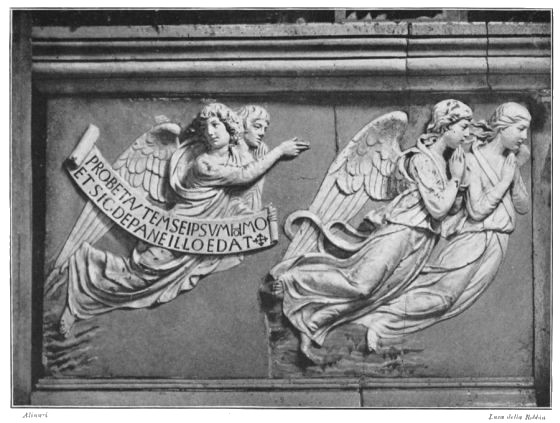
Alinari Luca della Robbia
PREDELLA TO TABERNACLE, CHAPEL OF THE HOLY CROSS, IMPRUNETA

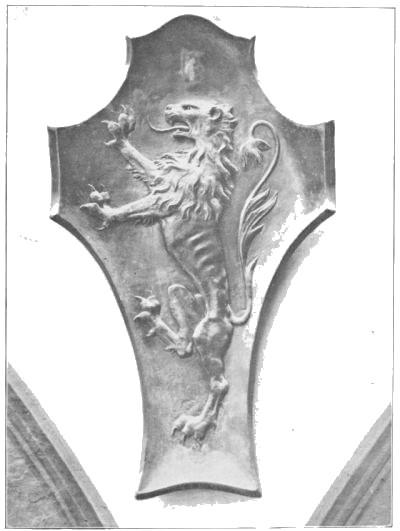
Alinari
STEMMA IN THE COURTYARD, PALAZZO CENAMI, LUCCA

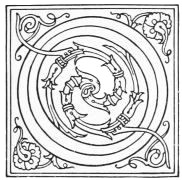 NE lucky day, as we were sauntering
about Pistoja, some one said: "Let us go to Serravalle, and get more
in touch with that stirring fellow, Castruccio Castracane, who seems
to have filled this region with war's alarum, and left his name, if
not more substantial marks, in every town in this part of Tuscany."
We remember that he bribed Filippo Tedici with ten thousand golden
florins, and so got possession of Pistoja and the traitor's daughter,
Dialta, as his wife, and that their wedding festivities took place in
the Piazza della Sala, where the Mercato is to-day; also, that when
Castruccio once got within the walls he ruled the city well.
NE lucky day, as we were sauntering
about Pistoja, some one said: "Let us go to Serravalle, and get more
in touch with that stirring fellow, Castruccio Castracane, who seems
to have filled this region with war's alarum, and left his name, if
not more substantial marks, in every town in this part of Tuscany."
We remember that he bribed Filippo Tedici with ten thousand golden
florins, and so got possession of Pistoja and the traitor's daughter,
Dialta, as his wife, and that their wedding festivities took place in
the Piazza della Sala, where the Mercato is to-day; also, that when
Castruccio once got within the walls he ruled the city well.
Serravalle is a picturesque little town but three miles from Pistoja, on the highway to Lucca—as pretty a walk as one could wish to take. It is clustered on[102] the top of a steep hill, and, if somewhat squalid in these later days, its ancient loggia, church, and castle are fine in colour and delightfully irregular and surprising in form. We climb up to the twelfth-century church, which contains a valuable old painting, then round the hill under an imposing loggia, and take our way up to the rocca, or castle, which Castruccio built early in the fourteenth century on a spur of the hill, an admirable place of defence, and which answers to its name by closing the valley (serra valle). From this vantage-point we have a good view of Pistoja on one side, on the other lies the fertile valley of the Nievole, so often Castruccio's battle-field. The grass is soft and green about the crumbling walls of the old castle now, and clumps of silvery-leaved olive trees, swept by Apennine breezes, brush gently against the old bastions and lofty six-sided tower, which command an outlook over the entire valley. The castle was evidently built out of ruins of earlier buildings, and probably erected in some haste to stay the progress of a dangerous enemy; but it must have been good, honest work to have lasted six hundred years, and Castruccio must have had a genius for building castles and fortresses, not only peculiarly adapted to his own needs of defence, but in such a way as to hold their own down through the centuries, and in their last ruinous state to challenge[103] universal admiration. At Sarzana the fortress he built and named Sarzanello is very different from the one at Serravalle, but perhaps even finer, and one can easily understand why Lorenzo, Il Magnifico, should wish to possess it as a thing of beauty, even had it not been supremely necessary to the northern defences of Florence on the Ligurian coast. It is planted on the brow of a hill overlooking the sea, and is a rather low, battlemented fortress of grey stone, its bastions, towers, and ponderous arches all surrounded by a moat.
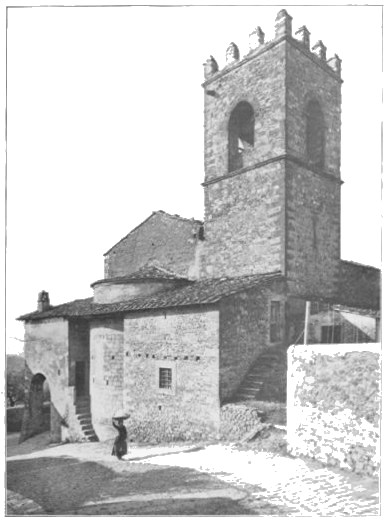
Alinari
APSE END AND CAMPANILE
CHURCH OF S. ANDREA, SERRAVALLE
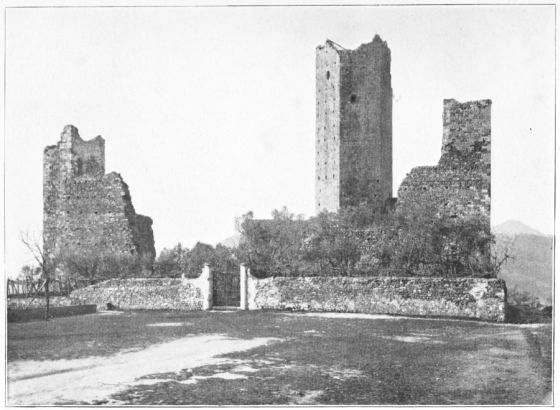
Alinari
RUIN OF THE ROCCA OF CASTRUCCIO, SERRAVALLE

M. M. Newell
OLIVE TREES
From the heights of Serravalle, looking toward Lucca, we see the mediæval bell-tower of Altopascio, and remember that one of Castruccio's signal victories over the Florentines took place there in 1323. The previous spring Castruccio had dashed into the lower Val d'Arno, taken several towns, and menaced Florence herself. Clearly his victorious career must be stopped; accordingly, Florence collected the finest army she had ever put in the field, headed by the carroccio and martinella, and marched to Pistoja, hoping to tempt Castruccio out of the city; but having spent some days insulting the garrison by games and races under the walls, the Florentines moved on toward Lucca. This was Castruccio's chance; rapidly following the great army, he surprised it at Altopascio, routed it completely, and then led the carroccio, with many noble prisoners, in triumphal procession through the gates of Lucca. A year later "he occupied Signa, pillaged Prato, laid siege to Montemurlo, and wasted the greater part of the Florentine contado."[5] But it would be impossible to follow Castruccio Castracane[107] through all his adventurous course, and it is time to inquire what manner of man he was. Ruskin calls him "the greatest captain of his age," an estimate probably made with nice distinction, for though he must be reckoned among the Italian condottieri, one of the "six sorts of despots," according to Mr. Symonds' classification,[6] "raging in Italy during the fourteenth and fifteenth centuries," he certainly differs essentially from tyrants like the Sforzi of Milan, the Scali of Verona, the Baglioni of Perugia, and others like them, who, springing from peasant or bourgeois ranks, became powerful enough to found kingdoms, maintain splendid courts, and follow their natural tastes for arts and the new learning. The Baglioni patronized Perugino; Il Moro had his Leonardo da Vinci; Petrarch had his seat of honour at Galeazzo Visconti's table, and the Malatesti dukes of Urbino displayed a passionate zeal for philosophy and art, while "the spell of science was stronger over them than the charms of love." Castruccio was unlike these tyrants, in that we hear nothing of his taste for books, or music, or art; indeed, by his ruthless devastation of the environs of Florence, incalculable treasures, representing early Italian art, were irretrievably lost; and though we know that Castruccio had sons and other kinsmen, there was no successor to the great "soldier of fortune who had raised himself to be Duke of Lucca, Lord of Pisa, Pistoja, Volterra, and much of the Genoese Riviera."[7] Castruccio may, perhaps, be compared with that "captain of adventure," Il Medeghino, son of a certain Bernardo de' Medici, not connected with the Medicean family of Florence, who delighted in war for its own sake, and by cunning and skill became master of the region about Lake Como, where he played the rôle of Marquis of Musso and Count of Lecco, setting up his court and coining money with his own name and devices. It was when he reached this dizzy point of success that he arrogantly assumed the arms of the Florentine family and swept the lake at the head of a squadron led by his flagship, from which floated a red banner with the golden palle of the Medici. When Il Medeghino died the Senate of Milan put on mourning, and in the cathedral we may see his splendid tomb, the work of Leone Lioni.[8] The services of Castruccio Castracane to the Ghibelline or Emperor's party in Italy were not recognized by such high honours. He led the simple, hardy life of a soldier, died in the harness at the beginning of a fresh campaign, and was buried at Lucca in the Church of S. Francesco, used now as a military magazine.
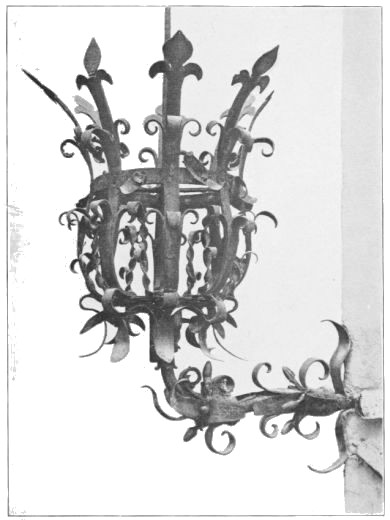
Alinari
AN IRON LANTERN, PALAZZO BARONI, LUCCA
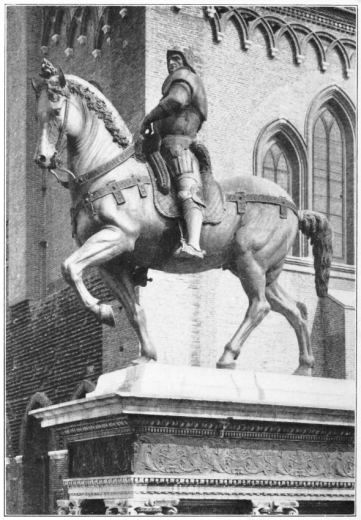
Alinari A. Verrocchio
MONUMENT OF GENERAL BARTOLOMMEO COLLEONI
CAMPO DI S. GIOVANNI E. PAOLO. VENICE

MOAT OF THE CASTLE SARZANELLO, SARZANA

Alinari Donatello
MONUMENT TO GENERAL GATTAMELATA, PADUA

Alinari Paolo Uccello
EQUESTRIAN STATUE OF JOHN HAWKWOOD
CATHEDRAL, FLORENCE
In physical strength and agility, in foxlike cunning and ready audacity, and in his sense of honour and justice, Castruccio resembles Bartolommeo Colleoni, of Bergamo, who trained under the greatest condottiere of his age, distinguished himself in many engagements for the Visconti, and was finally elected general-in-chief of all the Venetian forces by the Republic of St. Mark, and received his truncheon of office from[114] the hand of the Doge before the high altar of San Marco. At Bergamo we see his chapel, built by Amadeo, as a "monument of the warrior's puissance even in the grave." There also is the equestrian statue in gilded wood voted by the town of Bergamo, and, far more noteworthy, the beautiful tomb of his favorite daughter, Medea. But the great general's rightful monument is in Venice, where the "finest bronze equestrian statue in Italy, if we except the Marcus Aurelius of the Capital," was reared in his honour. The second great equestrian statue in Italy, strange to say, is also that of a condottiere—Erasmo da Narni, better known as Gattamelata, a noble work of Donatello, erected in the Piazza del Santo at Padua.
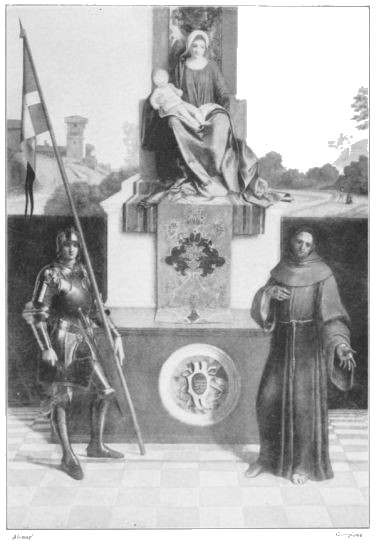
Alinari Giorgione
MADONNA AND CHILD, WITH TWO SAINTS
PAROCHIAL CHURCH. CASTELFRANCO

Hanfstaengl Botticelli
PORTRAIT OF A YOUNG FLORENTINE
ROYAL GALLERY, BERLIN
It is impossible to compare Castruccio exactly with any other free-lance of his time. There are condottieri and condottieri; the range is so wide and, defining lines so elastic that in the day when individuality was more marked than in any other period of the world's history, it is not strange to find in the same class such widely differing characters as Francesco Sforza, called the "great Condottiere," the brave and skillful but humane Carmagnuola, or the youthful Matteo Costanzo, who, in full armour and bearing the standard of the cross, figures as San Liberale in[117] Giorgione's celebrated Castelfranco Madonna and Child. Matteo died young, but had been trained as condottiere by his father, who gave Giorgione's Madonna to the Church, as a votive offering in memory of his lamented son. There was no bronze statue raised in Castruccio's honour, and no portrait of him is mentioned, though it is said he appears in Benozzo Gozzoli's Procession of the Magi in the Riccardi Palace, and in Orcagna's Triumph of Death in the Campo Santo of Pisa. Of his personal appearance, therefore, we are wholly ignorant, except for the tradition that he had red hair. Nor are we much more certain of his youth and training. Machiavelli's romantic account relates that he was a foundling, picked up in her vineyard by the kindly Dianora Castracane, of Lucca, who carried the infant home, and, calling her brother, a canon of San Michele, with whom she shared her house, tried to determine the child's future. After much discussion it was decided to give him the name of Castracane and educate him for the Church; but, though quick to learn, Castruccio had no taste or desire for the cloister; his one thought was for athletic sports, adventure, and the noble art of war. Playing with his fellows in the Piazza of San Michele, he attracted the attention of a nobleman of Lucca, who, when Castruccio was eighteen,[118] adopted him, trained him to arms, and, upon his death, confided to him the care of his estates and direction of his only son. His masters in war were the most notable military leaders of the time, and "Machiavelli goes to the length of saying that, as a general, he was not inferior to Philip of Macedon, or Scipio."[9]
The more sober historians hold that Castruccio was a member of the Interminelli family, who had been exiled in his youth, and gained much military experience in England when serving under Edward I. All accounts agree that he was a remarkable man, and one critic writes of him thus: "Not only as a soldier but as a statesman he was undoubtedly the foremost man in Italy, and it is not improbable that, had he lived, he would have subjugated the whole peninsula."

STEMMA OF SERRAVALLE

Alinari Della Robbia
MEDICI STEMMA
OSPEDALE DEL CEPPO, PISTOJA

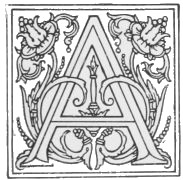 SPRING day comes suddenly in Val d'Arno when the air is a thought
too warm and over-rich with languorous fragrance from myriad blossoms.
Then thirst grows imperious for the uplands, for Tuscan hillsides clad
with chestnut-trees overshadowing uncut grass, through which sweeps
an eager breeze caught from the snow-capped Apennines. On such a day
we recall Pistoja, once seen on our way southward from Bologna, and
ever since haunting our minds like a sweet vision. We had crossed the
watershed which defines the boundary[124]
between Emilia and Tuscany, and were following, by many a curve and
loop, the Reno's tortuous course, when suddenly we sighted, perched
loftily upon the spur of the Apennines, a city's gleaming dome and
towers; another turn, and she was lost; again, from some hill-spanning
gallery, or viaduct, we snatched another entrancing glance, and so, by
coy circlings down the pass, we drew nearer and nearer until the train
paused for a moment without the gates of Pistoja, then carried us on to
Florence, twenty miles away. But we had treasured always in our mind
the vision of that city, with gleaming dome and towers, that keeps her
watch at the northern gate of Tuscany. Short as is the distance between
Florence and Pistoja, there is a marked change in the atmosphere, which
acts as a healthy tonic on the dolce far niente of a Florentine
spring. We enter Pistoja through the Porta Carratica, or Fiorentino,
still emblazoned with the Medici shield, and find[127]
ourselves shortly in the very centre of a pleasant, busy
city, its clean, wind-swept streets broad and well paved,
the principal ones following the lines of the first two
mediæval walls, for Pistoja, like Florence, has had three
circles, the last of which, built in the fourteenth century,
remains almost intact. Along this wall are pleasant
walks and a boulevard called the Viale dell'Arcadia,
planted with shade-trees and commanding extensive
views. If now your conscience stirs actively to "do"
Pistoja thoroughly, there's a stiff day's work before
you. The list of churches alone is formidable, not
counting those which have been diverted from original
purposes. Nearly every church contains something
worth seeing: paintings and sculptures, three celebrated
pulpits at least, tombs, fonts, and Della Robbia
reliefs; moreover, there are the libraries and the
famous hospital, or Ospedale del Ceppo—altogether
an outlook beyond words discouraging. It is better
to stand about the Piazza del Duomo, or Cathedral
Square, perhaps the most representative one in Tuscany,
the centre for a thousand years of the social, civil,
and religious interests of the town. Here are the cathedral
and Bishop's palace, the Palazzo Pretorio, or
Podestà, and the Palazzo Pubblico, or, in other words,
the Court House and City Hall, representing the ancient
warring powers of Church and State. Here they[128]
are on their old battle-field, temporal power jealous of
spiritual aggressions. Even the weather-beaten Torre
del Podestà is not wholly committed as a campanile,
but stands off a little from the cathedral, remembering
that it was once the city's watch-tower, its tocsin sounding
alarm to Guelf and Ghibelline, blacks and whites,
and all invaders. The bishop was no insignificant
power when the Commune was struggling for independence.
He had his many feudal castles, armed
retainers, and vassals; his court dealt sternly with culprits,
and his dungeons, under the palace yonder, were
more feared than those of the Podestà. Not that the
City Fathers were not proud of their powerful bishop
and their noble cathedral, dedicated to St. Zeno, and
containing the silver altar of San Jacopo, patron saint
of the city, which drew crowds of pilgrims every year
to worship at the famous shrine. Not a few popes
journeyed from Rome to visit the bishop, and noble
visitors of every land, from the Emperor of the East
to Bonaparte, had filled the square with their trains and
followers. But the commune of Pistoja, like many another,
had a bitter struggle to keep her footing, though
she began well and very early; her first municipal statutes,
and good ones they were, too, being framed in
1117, immediately after the death of "the great Countess"
Matilda. It was battle royal for many centuries;[131]
but now Church and Commune live peacefully side by
side, forgetful of the stormy past, except when they
turn over their priceless archives, preserved in the
chapter of the cathedral and the Palazzo Pubblico, where
one may read a thousand interesting and thrilling
things concerning the history of Pistoja, of the men
who built churches and palaces, and called the great
artists of the Renaissance to come and fill them with
paintings and sculptures, wood-carving, and metal-work.
And the city grew so proud and magnificent
that we read of sumptuary laws promulgated to restrain
extravagance of nobles and burghers in the matters of
dress, jewelry, food, and pomp at funerals. The law
of 1439 forbade trimmings of gold and silver brocade,
long trains to ladies' dresses, the quality of sleeve-linings,
etc. Unluckily, many of the archives belonging
to the cathedral were destroyed in the fires of 1108
and 1202; hence the endless discussions as to the
city's origin and name. "Etruscan," says one. "Far
from it," says another; "I have found a Roman house,
mosaic, and coins a dozen feet under the pavement of
the square, which must have been the centre of the
earliest city." As for its name, some derive it from
two Etruscan words, pist (door) and oros (mountain),
referring to the position of the city at the entrance of
a mountain pass; others get the name from pistores
(bakers), the early city
having been celebrated
for its excellent ovens.
SPRING day comes suddenly in Val d'Arno when the air is a thought
too warm and over-rich with languorous fragrance from myriad blossoms.
Then thirst grows imperious for the uplands, for Tuscan hillsides clad
with chestnut-trees overshadowing uncut grass, through which sweeps
an eager breeze caught from the snow-capped Apennines. On such a day
we recall Pistoja, once seen on our way southward from Bologna, and
ever since haunting our minds like a sweet vision. We had crossed the
watershed which defines the boundary[124]
between Emilia and Tuscany, and were following, by many a curve and
loop, the Reno's tortuous course, when suddenly we sighted, perched
loftily upon the spur of the Apennines, a city's gleaming dome and
towers; another turn, and she was lost; again, from some hill-spanning
gallery, or viaduct, we snatched another entrancing glance, and so, by
coy circlings down the pass, we drew nearer and nearer until the train
paused for a moment without the gates of Pistoja, then carried us on to
Florence, twenty miles away. But we had treasured always in our mind
the vision of that city, with gleaming dome and towers, that keeps her
watch at the northern gate of Tuscany. Short as is the distance between
Florence and Pistoja, there is a marked change in the atmosphere, which
acts as a healthy tonic on the dolce far niente of a Florentine
spring. We enter Pistoja through the Porta Carratica, or Fiorentino,
still emblazoned with the Medici shield, and find[127]
ourselves shortly in the very centre of a pleasant, busy
city, its clean, wind-swept streets broad and well paved,
the principal ones following the lines of the first two
mediæval walls, for Pistoja, like Florence, has had three
circles, the last of which, built in the fourteenth century,
remains almost intact. Along this wall are pleasant
walks and a boulevard called the Viale dell'Arcadia,
planted with shade-trees and commanding extensive
views. If now your conscience stirs actively to "do"
Pistoja thoroughly, there's a stiff day's work before
you. The list of churches alone is formidable, not
counting those which have been diverted from original
purposes. Nearly every church contains something
worth seeing: paintings and sculptures, three celebrated
pulpits at least, tombs, fonts, and Della Robbia
reliefs; moreover, there are the libraries and the
famous hospital, or Ospedale del Ceppo—altogether
an outlook beyond words discouraging. It is better
to stand about the Piazza del Duomo, or Cathedral
Square, perhaps the most representative one in Tuscany,
the centre for a thousand years of the social, civil,
and religious interests of the town. Here are the cathedral
and Bishop's palace, the Palazzo Pretorio, or
Podestà, and the Palazzo Pubblico, or, in other words,
the Court House and City Hall, representing the ancient
warring powers of Church and State. Here they[128]
are on their old battle-field, temporal power jealous of
spiritual aggressions. Even the weather-beaten Torre
del Podestà is not wholly committed as a campanile,
but stands off a little from the cathedral, remembering
that it was once the city's watch-tower, its tocsin sounding
alarm to Guelf and Ghibelline, blacks and whites,
and all invaders. The bishop was no insignificant
power when the Commune was struggling for independence.
He had his many feudal castles, armed
retainers, and vassals; his court dealt sternly with culprits,
and his dungeons, under the palace yonder, were
more feared than those of the Podestà. Not that the
City Fathers were not proud of their powerful bishop
and their noble cathedral, dedicated to St. Zeno, and
containing the silver altar of San Jacopo, patron saint
of the city, which drew crowds of pilgrims every year
to worship at the famous shrine. Not a few popes
journeyed from Rome to visit the bishop, and noble
visitors of every land, from the Emperor of the East
to Bonaparte, had filled the square with their trains and
followers. But the commune of Pistoja, like many another,
had a bitter struggle to keep her footing, though
she began well and very early; her first municipal statutes,
and good ones they were, too, being framed in
1117, immediately after the death of "the great Countess"
Matilda. It was battle royal for many centuries;[131]
but now Church and Commune live peacefully side by
side, forgetful of the stormy past, except when they
turn over their priceless archives, preserved in the
chapter of the cathedral and the Palazzo Pubblico, where
one may read a thousand interesting and thrilling
things concerning the history of Pistoja, of the men
who built churches and palaces, and called the great
artists of the Renaissance to come and fill them with
paintings and sculptures, wood-carving, and metal-work.
And the city grew so proud and magnificent
that we read of sumptuary laws promulgated to restrain
extravagance of nobles and burghers in the matters of
dress, jewelry, food, and pomp at funerals. The law
of 1439 forbade trimmings of gold and silver brocade,
long trains to ladies' dresses, the quality of sleeve-linings,
etc. Unluckily, many of the archives belonging
to the cathedral were destroyed in the fires of 1108
and 1202; hence the endless discussions as to the
city's origin and name. "Etruscan," says one. "Far
from it," says another; "I have found a Roman house,
mosaic, and coins a dozen feet under the pavement of
the square, which must have been the centre of the
earliest city." As for its name, some derive it from
two Etruscan words, pist (door) and oros (mountain),
referring to the position of the city at the entrance of
a mountain pass; others get the name from pistores
(bakers), the early city
having been celebrated
for its excellent ovens.
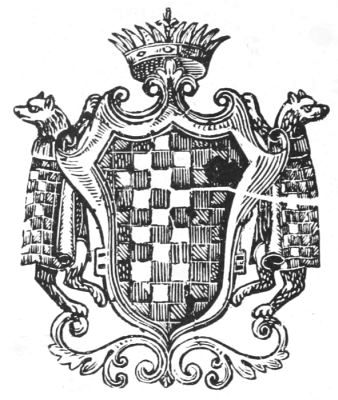
THE LITTLE BROWN BEARS AND THE SHIELD OF PISTOJA

Alinari
PIAZZA DEL DUOMO, PISTOJA

Alinari Verrocchio
STEMMA OF PISTOJA
PALAZZO PUBBLICO. PISTOJA
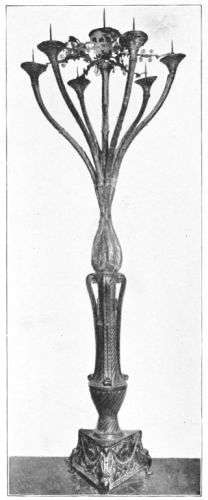
Alinari
BRONZE CANDELABRA (15TH CENTURY)
The Pistoja of to-day is a prosperous and attractive city with good buildings, fine markets, and many industries; she has been noted from time immemorial for her skilled work in iron, bronze, and wood, and her ancient metal-work has been found in Germany and Athens. In her bronze foundries to-day she not only casts bells and small articles, but many statues and groups created by Italian artists are cast in Pistoja. The manufacture of carriages and fine organs is of great importance. The district has four paper-mills, and of the eleven brass foundries in the[133] province five are situated at Pistoja, and many skilled workmen are employed in wood-carving, artistic ironwork, etc. Her trade is mainly in wine, oil, grain, paste alimentare, and cattle. The milk and butter of Pistoja are considered the best in Tuscany. To appreciate the varied productions and interests of the district of Pistoja you must wander about the Piazza del Duomo on market-day when it is filled with booths offering woolen, linen, and cotton stuffs, bright kerchiefs, shawls, shoes, and "notions," displayed in picturesque confusion and colour; a score of red, yellow, and green umbrellas in one corner, or a line of contadini overcoats of a warm brownish-red colour, trimmed with tawny fur and lined with green, delight the eye and are much in demand. Or walk through the Mercato, old as Pistoja herself, where the ancient well indicates the very centre of the first city. Here is certainly every object man can want, and the square blooms daily with all kinds of fresh vegetables and flowers: there are grains and food of every sort; in the season there are piles of yellow cocoons on the pavement; bright-faced old women are roasting chestnuts gathered on the mountain side; pretty baskets of fragrant wild strawberries are proffered by some handsome young girl, and the stall of some descendant of the old race of pistores is hung with rings of sweet, fresh pane nero (brown bread), while various kinds of cheese and the "best butter" await your choice. The markets for fish and meat are in different parts of the city.
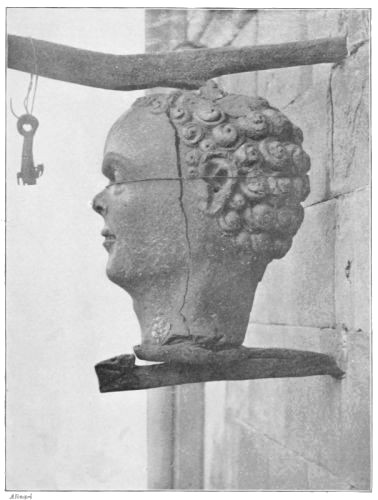
Alinari
HEAD OF THE TRAITOR, FILIPPO TEDICI
PALAZZO PUBBLICO. PISTOJA
By this time the exhilarating, almost heady, mountain air has created a ravenous appetite, and we clamour, above all else, for a taste of the Mercato's tempting products served in appetizing dishes known only to the true Italian chef. Our wishes may be easily gratified at the Albergo Globo e Londra, in Piazza Cino, where cooking is good and native wine excellent. If this luncheon could have been served in a pleasant garden, the only proper banquet-hall for Italy, nothing further could be desired; but it is only fair to warn the traveller who means to sleep in Pistoja that the chambers of the Globo are by no means tidy or attractive.
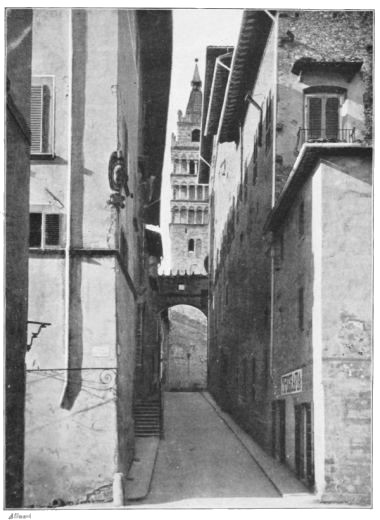
Alinari
THE CAMPANILE FROM VIA RIPA DEL SALE, PISTOJA
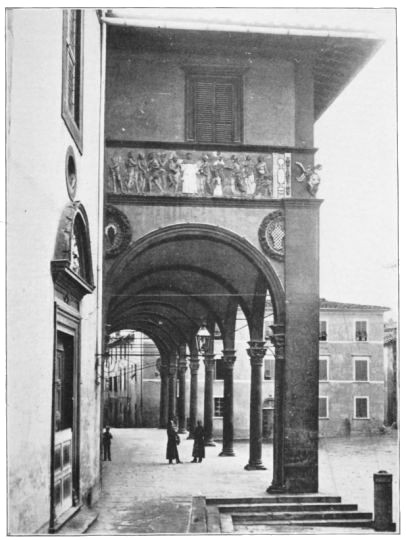
Alinari
THE LOGGIA, OSPEDALE DEL CEPPO, PISTOJA
Now for a stroll through the quaint old streets with curious and suggestive names, and a peep into quiet courtyards of palaces deserted by their noble owners, and given over to modest householders and humble artisans. At the corner of Via Abbi Pazienza and the Via de' Rossi is the great palace of the Rossi family, blazoned with many shields of varied quarterings, and from the corner hangs one of the gruesome black heads of the traitor Filippo Tedici, like that on the façade of the Palazzo Pubblico. Many of the oldest[139] streets of Pistoja lead from the Piazza del Duomo, and their names suggest the life of an earlier day: Via Orafi (jewelers) was once devoted to goldsmiths' shops and studios; the Via Stracceria (rags) was so called because clothing of all sizes, colours, and condition was hung to dry from windows and other "coigns of vantage;" and the Via Can Bianco was named in honour of a faithful white dog, whose barking warned his master of the approach of an enemy. Near the east end of the cathedral we may leave the square by the Via Ripa del Sale, a narrow street over-arched by a gallery connecting the Palazzo Pubblico with the duomo, convenient for the worshipful magistrates when they desired to hear mass. This street leads us, with often a backward glance at the campanile, to the Via Filippo Pacini, a broader thoroughfare following the line of the first city wall, and in two minutes we stand in the little irregular square of the Ospedale del Ceppo and before the famous Della Robbia frieze, an experience which, to one of us at least, seems almost a miracle. So many years Pistoja had been merely a dream city, a name—a curious, unreal name—standing only for this little piazza, this loggia, and the brilliant band of varied colour crossing its façade. Those imperfect guide-books of our youth had merely mentioned as important, this glazed terra-cotta frieze, wrought, it seemed to us,[140] through some magic by the members of one family only, the secret of which vanished from the world forever upon the death, in 1529, of the last true Della Robbia, the author of this frieze. Tradition added that the formula for compounding the Della Robbia glaze was supposed to be hidden behind one of the panels, one of which was afterward found broken, the robber leaving no trace of the precious parchment. The panel, "Giving Drink to the Thirsty," was repaired, but not like the others. We can see for ourselves that it is only painted stucco and of later date. This was a story to stir youthful imagination to the highest pitch: a mystery, a secret, a theft—the very stuff that dreams are made of. Italy is full of traditions; even the origin of this self-same hospital is a pretty story, as told by a worthy canon of the cathedral, and who would wish to question it? "The Church of Santa Maria del Ceppo (meaning a dry root) was built near the little stream Brana about 1277, by the pious Theodore and his wife Bandinella, who dedicated it to the Assumption, and placed therein an alms-box for the benefit of the sick and poor. This chest increased little by little, until it became the present hospital. The chiesetta (little church) was incorporated in the large building." Time and the schools have taught us the meretricious value of traditions,[143] but even stripped of all glamour the Della Robbia frieze is unique as an architectural feature, and peculiarly appropriate to the building it adorns. It consists of seven panels, representing the temporal works of mercy as performed by the good brothers of the hospital; between them are figures representing the Virtues: Faith, Hope, Charity, Prudence, and Justice; below appear medallions of the arms of the city, of the hospital (the sprouting root), and the Medici shield; also the Annunciation, Visitation, and Assumption. Of all the panels, the "Sheltering of the Pilgrims," and the "Healing of the Sick," are considered the finest; the figures of the brothers in both have evidently been studied from life, especially that of the physician. More beautiful, however, than any part of the frieze is Benedetto Buglioni's "Coronation of the Virgin," a lunette over the chapel door of excellent workmanship, and in simple colours, white on blue, with crowns of pale yellow. In its modelling and glaze, its seriousness and grace, it almost rivals Luca della Robbia's masterpiece in Pistoja, "The Visitation," in the Church of St. John the Evangelist. If there is a moment to spare we may well slip round the corner for a peep at the Church and Convent of Santa Maria delle Grazie, where a calm-faced sister—one of the good Bandinella's descendants, wearing the pretty wimpled[144] cap of white muslin, designed, it is said, by some tasteful lady of the Medici family—will show us their perfect little Renaissance church and its great treasure, the Lorenzo di Credi Madonna, and also insist gently upon a visit to the Miraculous Bed where once the Madonna reposed. They will further offer to exhibit their store of fine vestments and robes, well worth looking at; but if once we begin looking at churches and vestments there will be no getting back to Florence for a week. But at least we must take leave of our hosts, those stately shades of forceful men belonging to Renaissance Pistoja, who worked and wrought in these streets, whose prowess and policy, wit and learning, are so vivid in men's minds to-day. Pistoja entered with characteristic zest into the spirit of the Renaissance in all its varied aspects; she espoused the new learning, her libraries were filled with Greek and Latin manuscripts; she was famed for her able jurists and historians, her singers and poets were welcome at the proudest courts of Italy. We read that Antonio da Pistoja was invited by Lodovico il Moro to Milan, "in hope of refining and polishing the rude Lombard diction," and that the charming and learned Isabella d'Este, Marchesa of Mantua, wrote to her envoy: "Find out Messer Tebaldeo (of Pistoja), and beg him to send twenty or twenty-five sonnets, as well as two or three[146] capitoli, which would give us the greatest possible pleasure."

Alinari Della Robbia School
COAT OF ARMS OF THE HOSPITAL, PISTOJA
No more typical family can be found, perhaps, than the Forteguerri of Siena and Pistoja, which was noted for its brave and learned sons and daughters, and beloved and honoured for devotion to their country, for their benevolence, learning, and poetic genius. As early as 1179 we find a Forteguerra as consul of Pistoja; in the fifteenth century Cardinal Forteguerra was not only conspicuous in the Church, but a constant friend and benefactor to his native city, founding and endowing a college and library. His grateful city erected a monument to his memory in the Piazza del Duomo, and called Verrocchio to design and carve a fitting tomb in the cathedral; but the work was not concluded by the master's hand, nor in accordance with his clay model, which we see to-day in the South Kensington Museum; and looking at the tomb, evidently the work of many diverse hands, one can but wish that the good Cardinal might have at Pistoja at least a replica of the one, by Mino da Fiesole, in the Church of St. Cecilia, Rome. Besides Cardinal Niccolò, there was more than one bishop, many jurists and historians in the Forteguerri family, and no less than six poets. The fifteenth Forteguerra, of the Pistoja branch, was another Niccolò (1674-1735), a well-known and cultured church-man[148] at the court of Pope Clement XI, and author of a long, satirical poem, "The Ricciardetto," besides verses called "capitoli," and various translations from the Latin. This Niccolò was evidently conversant with Roman society, and a close observer of men and politics; he shows himself, also, at the age of fifty, a good lover, not only singing his lady's praise in verse, but sending her frequent vivacious and friendly letters, half in jest, but often dangerously near earnest affection; and the name of some Arcadian maiden of his muse, some Daphne or Phyllis, thinly conceals the identity of the noble young Roman lady, Marianna Cenci Bolognetti. It appears that the women of the family Forteguerri were also brave and talented; at least, we have a record of one of the Siena branch, when in 1554 the city was besieged by the Spaniards and almost spent with famine; when the best men of Siena were losing courage, "women of gentle birth, leaders of society, worked at the defences, side by side with artisans and common soldiers. All the Sienese ladies divided themselves into three companies; the first was led by Signorina Forteguerra, who wore a violet uniform, as did those who followed her; ... these three squadrons were composed of 3,000 ladies of the upper and middle classes. They bore pikes and spades, panniers and hurdles; as they went to their[149] work on the fortifications, these brave women sang a song composed by one of that numerous choir of poetesses who sang the swan song of their own country." This Signorina Forteguerra is the one whom the English diarist, Hoby, mentions. "Most of the women of Siena," he says, "are well learned and write excellentlie well in prose and verse: among whom Laodomia Forteguerra and Virginia Salvi did excell for good wittes."
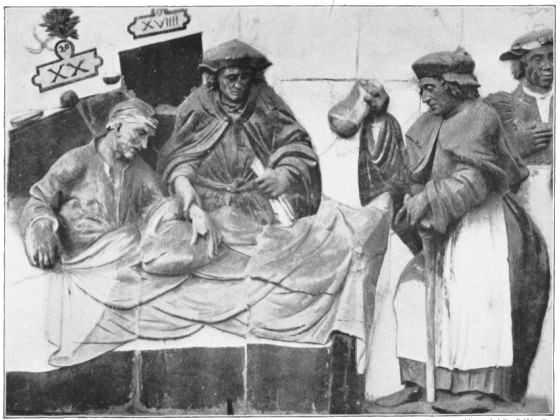
Alinari Giovanni della Robbia (?)
HEALING OF THE SICK
(DETAIL OF FRIEZE), OSPEDALE DEL CEPPO, PISTOJA
Pistoja is called the "City of Cino" because of her famous lawyer-poet, Guittoncino (always called by the fond diminutive "Cino"), of the noble house of Sinibuldi, which had given Pistoja one bishop and many gonfaloniers. Though belonging to the thirteenth century, his noble character, his ability as a jurist, the pure and graceful style of his "Comments on the Codices," his faultless letters and verse—above all, his friendships and love story—have kept his memory fresh. He enjoys even to-day a certain fame in Italy, and all the world is supposed to know his charming sonnets, addressed to his friends, among whom were Dante and Petrarch, and to the lady Selvaggia dei Vergiolesi. His monument in the cathedral, erected by the Commune, is by Cellino di Nese, and is the first of the "monuments of the professors," a class of work characteristic of the coming period; it shows Cino lecturing on law[152] to his pupils, among whom are Baldus, commentator on Civil Law, and the "idle Petrarch;" there appears also a draped female figure, which may personify poetry, or Roman Law, or, as some will have it, the fair lady of Cino's devotion, Selvaggia dei Vergiolesi; unsentimental critics, however, are inclined to think that the figure is that of the Madonna, and was once a part of a relief of the Annunciation. Selvaggia's family was Ghibelline, and, banished from Pistoja in 1305, retired to their strong castle, where the beautiful Selvaggia died at the age of twenty, after which Cino became a wanderer in foreign lands: he crossed the Alps and took up his abode in Paris, where he pursued[153] his studies for some time. Cino's letters to Selvaggia and to his other friends, in which he sang his love and suffering, are exquisite in their purity and elegance of diction, and place him among the great makers of the Italian language. To Dante he wrote an ode condoling with him upon the death of Beatrice in tender and musical lines. He died in his native city of Pistoja at the age of sixty-six, upon which Petrarch composed his celebrated lament, beginning:
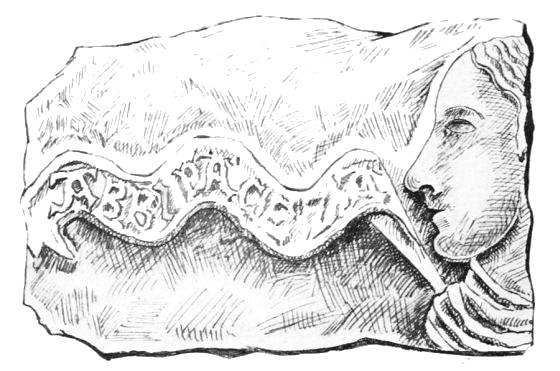
VIA ABBI PAZIENZA

Alinari Benedetto Buglioni
CORONATION OF THE VIRGIN
OSPEDALE DEL CEPPO, PISTOJA

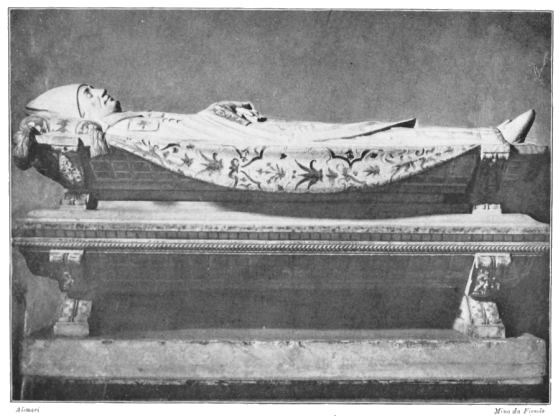
Alinari Mino da Fiesole
MONUMENT OF CARDINAL NICCOLÒ FORTEGUERRA
CHURCH OF S. CECILIA, ROME

Alinari Fra Bartolommeo
THE VIRGIN AND CHILD ENTHRONED, AND SAINTS
CATHEDRAL, LUCCA
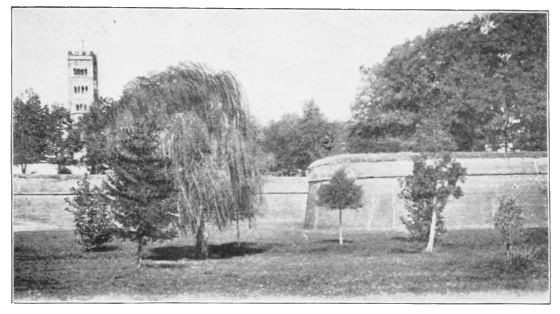
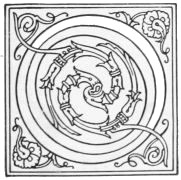 N St. Patrick's Day in the morning
we left Florence, had a full
day's sight-seeing in Pistoja, Groppoli,
and Serravalle, and pushed
on to Lucca the same evening,
arriving about seven o'clock.
N St. Patrick's Day in the morning
we left Florence, had a full
day's sight-seeing in Pistoja, Groppoli,
and Serravalle, and pushed
on to Lucca the same evening,
arriving about seven o'clock.
Acting on sound British advices, we drove at once to the Albergo dell'Universo, a comfortable little inn occupying the first floor of the old Palazzo Arnolfo, where we had our belated dinner,[164] took our ease before a cheerful open fire, and congratulated ourselves that at last we were in Lucca—a hope long deferred.
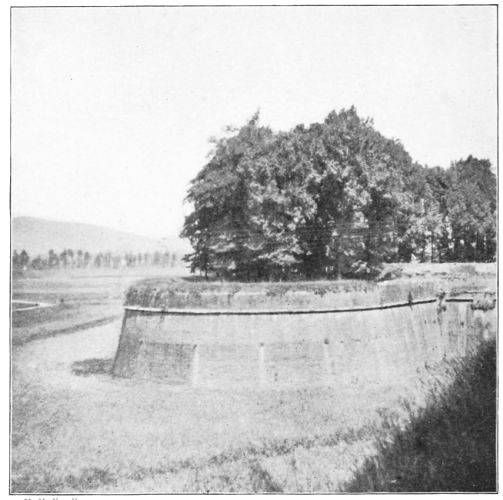
M. M. Newell
THE OLD CITY WALL AND MOAT, LUCCA

Alinari Jacopo della Quercia
TOMB OF ILARIA DEL CARRETTO, CATHEDRAL, LUCCA
The morrow is crisp and brilliant; and, forgetful of our guide-book's express advice, to crown and finish our Lucca visit with a walk on the ramparts, we turn[167] our backs on churches and priceless works of art and hasten at once to the old city walls. How faithfully those mediæval bricklayers did their work! Their walls, well preserved, still surround the town, no longer bristling with engines of war, but planted thick with shade-trees—elms, acacias, and limes—affording one of the most beautiful promenades in Italy. Lifted well above the city streets, they command extensive views on every side: here the broad, fertile plain, stretching to the Arno; yonder, at the north, the chain of rugged Apuans, two sharp peaks of which are now capped with glistening snow; southward rise the heights of Monte Pisani, noted in Roman days, and since, for its hot-springs. From thence comes the pure drinking-water for Lucca, conveyed by an aqueduct built by the Duchess Marie Louise, for which her grateful people erected a monument in her honour. As it crosses the sunlit plain on its four hundred and fifty-nine grey stone arches, we are reminded of the Roman Campagna, and remember that Lucca, in the day of her greatest splendour, was a favorite summer residence for the Romans, and that many traces still exist of their occupation, particularly the massive arcades of an amphitheatre in the present market-place. Standing on the old ramparts, on a rare spring morning, ten chances to one you forget all the sights awaiting you down[168] there, in the "city of the Magnificent People and Commune of Lucca"—its palaces, towers, and picture-galleries, its chapels and churches, of which there are no less than seventy "to satisfy the wants of 22,000 souls." The fame of San Frediano's seventh century church, with its magnificent tower, its sculptured[169] font and Madonna, has reached us over sea. For years we have yearned to look on Jacopo della Quercia's marble of that fair lady, Ilaria del Carretto, resting in the transept of St. Martin's cathedral. We know there are paintings by Fra Bartolommeo, palaces and libraries; but the fresh mountain air has driven all these things from our desire; we only long for those mountains delectable, those chestnut-crowned hills and distant grey towers. We begin to ask why we should study the churches of Lucca, and who is Matteo Civitali that he should keep us within the city walls? We consult time-tables and guide-books; there's a tram, they tell us, leading out of Porta Santa Maria in ten minutes, and if we catch it we may ride six miles, and then ... perhaps a carriage may be found, though it is early in the season. "But," importunes the handsome driver of the cab waiting to take us to the tram, and who in some way has divined our wants, "the tramvia will not take the signore to the hills, and surely there is no carriage at Ponte Moriano so early in the year. Ecco, this buon cavallo and your devoted Pepino, who will take you all the way so comfortably!" Off comes the shabby hat with inimitable native grace, and the bold, brown eyes are convincingly eloquent. You can no more resist Pepino's reasoning than that rush of mountain air on the ramparts. All preconceived plans are fast taking flight; but Prudence keeps her head and demands with thrifty caution, "How much, inclusive, there and back?" Then Pepino: "Oh, a mere bagatelle, my illustrissime signore, only twelve lire." Prudence, scouting this declaration with lofty scorn inspired by a profound knowledge of tariffs and coachmen from Paris to Palermo, exclaims: "Preposterous! Ten francs it shall be, and not a centesimo more." "Ah, signorina, the roads are very steep and it will take my whole morning," returns Pepino, beseechingly; but in vain he seeks for a sign of relenting. His struggle is brief, and, with a deprecating flourish of his small, shapely hands, he mounts the box, and the air with which he says, "as you will have it, signorina," is that of a gracious conqueror dictating terms to the vanquished; he cherishes no resentment, he has no interest but ours. We never for a moment regret the tram. Pepino knows every villa and grey tower, every path through the hills, every bridge over the torrenti; he never intrudes his knowledge, and, above all, he is kind to his horse.
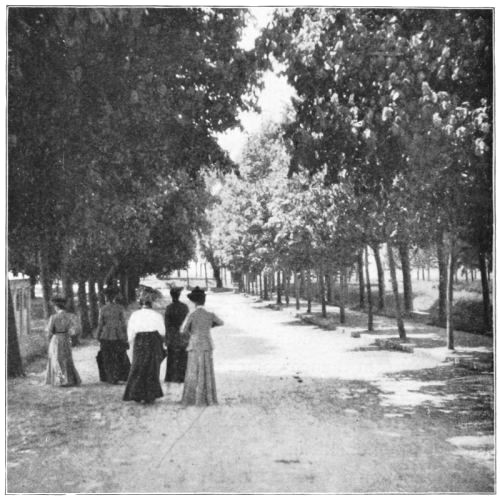
M. M. Newell
ON THE RAMPARTS, LUCCA
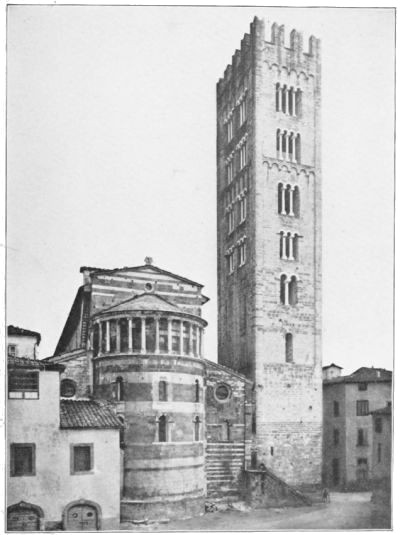
Alinari
S. FREDIANO, LUCCA
EAST END, WITH THE CAMPANILE (11TH AND 13TH CENTURY)
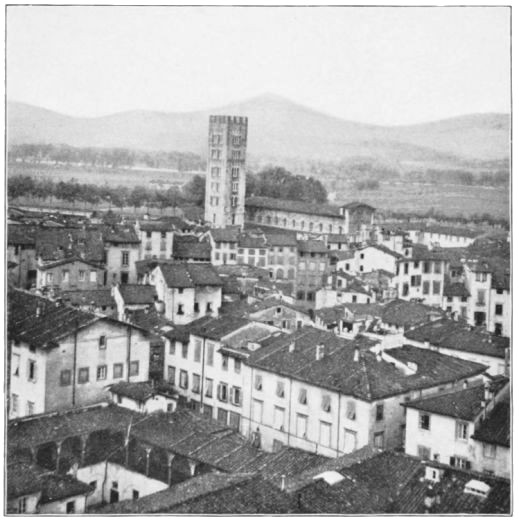
M. M. Newell
SAN FREDIANO FROM THE GUINIGI TOWER, LUCCA
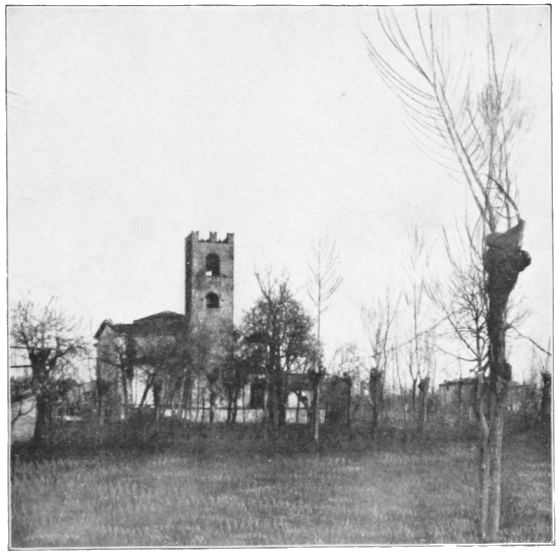
M. M. Newell
A "GREY TOWER"
"Yonder cross on the round, bare hill," he says, "is Brancoli," and Brancoli is the hill of our desire. Our good road at first runs over the plain following the east bank of the Serchio, principal river of the province; it rises in a northernly valley among the Apuans and fed by many a mountain stream or torrente, maintains a southeasterly course almost to Lucca, which it avoids by a broad loop westward, and then makes its way to the Mediterranean almost parallel with the Arno. We pass clusters of farm-houses, well-cultivated fields and vineyards, until in less than an hour we reach Ponte Moriano, which is little more than a busy street of shops and dwellings, but has a good stone church founded by San Frediano in five hundred and something. Its rather tall, square tower, of good proportions and crenellated battlements, is characteristic of all the church towers in this region. Here is the terminus of the tramvia, and Pepino was right, there is no appearance of a carriage; but his Italian for "I told you so," was kept under his breath with true Lucchese courtesy.
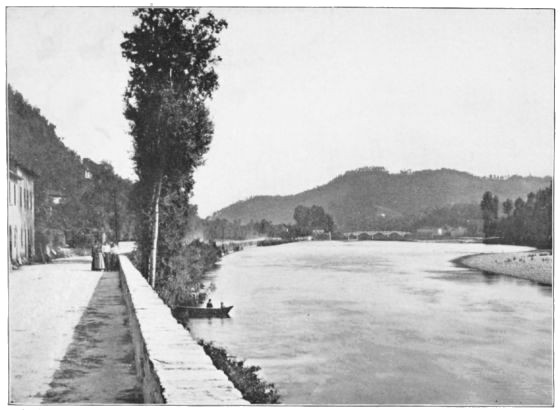
Alinari
PONTE A MORIANO, WITH A VIEW OF THE SERCHIO RIVER

M. M. Newell
AN OLD STONE BRIDGE
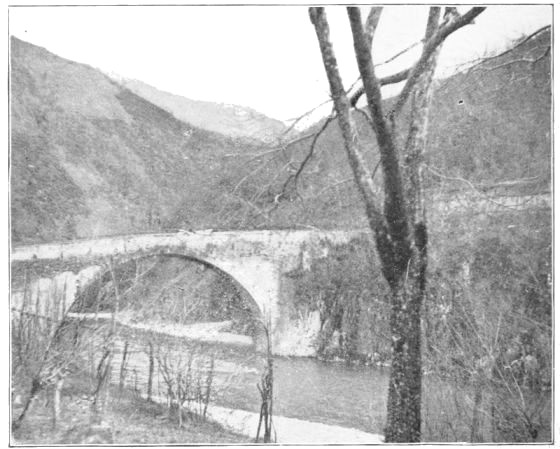
M. M. Newell
BRIDGE OVER THE SERCHIO RIVER
A mile farther on is the little hamlet of San Giusto, situated at a point where the Lima joins the Serchio. Here we leave the main road, turn sharply to the right, and follow the windings of the little river, which is crossed by the picturesque stone bridge of Vinchiana. An old mill, half hidden by white birches, turns its moss-covered wheel close under the steep river banks,[178] overhung with a tangle of vines and flowery shrubs. The road becoming rather steep, we now leave the carriage and proceed on foot. What an entrancing walk it is! Always ascending, we follow the turnings of the stream, now far below, and glancing like a silver thread along the valley. We round the grey shoulders of jutting cliffs, where clumps of white heather are in full bloom and the "maidenly birches" are touched with the first tender green; the air is intoxicating in its freshness, and the sky never so blue. "Ecco!" calls Pepino. "Ecco! San Ilario!" How has the fellow guessed that we ought to study churches rather than maunder about posies! The little church of cut stone, flanked by its good tower, stands hard by the roadside, convenient and inviting to tired feet and aching[182] hearts, as many a pilgrim in the old days knew full well. Its doors stand open wide, admitting floods of sunshine and spring fragrance. We enter unbidden, to find the little temple quiet and empty, all its pictures and sacred emblems covered, and all as clean and fresh as if waiting in reverent silence the miracle of Easter morning. We proudly boast the stern old Puritan blood running cool and inviolate in our veins, but there's a silent appeal in these modest temples and shrines of the elder faith that "must give us pause," and silence the voice of criticism. Taking the road again, we still ascend from one fold of the hill to another, whence we overlook the Serchio pursuing its lazy course far below, the views becoming more and more beautiful, until in half an hour we come upon the little stone church of San Lorenzo, close by the road. Small as it is, San Lorenzo is as complete in all its attributes, and as true to its architecture, as a full-fledged duomo, even to the little apse. The sturdy tower, square and shapely, small, round-arched windows and sides of warm, grey stone, the red-tiled roof, flecked with patches of green moss, make a charming picture, found in no country but Italy. This time the church is closed, but there are keys hanging in the north door, perhaps entering the sacristy, and we make bold to peep. It is a clean and cold room, entirely separated from the church proper, and evidently serving at present for a store-room, as a slender stock of various commodities and a few bottles of wine attest. Meantime Pepino has made our wants known at the near farm-house, and is returning, accompanied by a handsome young girl with the keys to the proper church door, which she opens, saluting us with respectful dignity, and, without questioning, draws the curtain from the Della Robbia over the altar; for well she knows that the forestieri only come to see our "beautiful white San Lorenzo." The statue is small and perfect, like everything about this woodland chiesetta. The head is exquisitely modelled, all in white, with the finish and the ivory-tinted glaze which belongs to Andrea Della Robbia's best work, though the wise in such matters ascribe it to one of his pupils.
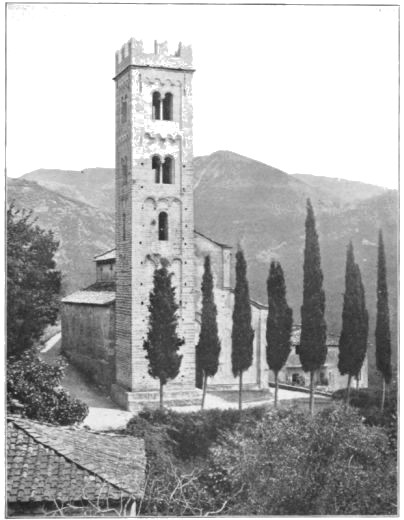
Alinari
PARISH CHURCH OF S. MARIA E S. GIORGIO (11TH CENTURY)
BRANCOLI

M. M. Newell
SAN LORENZO, BRANCOLI

Alinari
THE INTERIOR (11TH CENTURY), PARISH CHURCH OF S. MARIA
E S. GIORGIO, BRANCOLI
Saying our buon giorno, and pressing a small fee into the reluctant hand of the handsome contadina, we now turn from the carriage road and begin a short but rather difficult climb up the steep hillside by a roughly paved path, which leads us through chestnut woods to the crest of the hill and the parish church of Santa Maria e San Giorgio, belonging to the eighth century. We have seen it all the way from the plain, perched on a commanding height, surrounded by its sombre guard of stately cypresses. The tower is especially[186] fine in its proportions and built quite apart from the church, though only a foot or so from its walls. Unusually tall, it has four orders of arched windows, and is crowned with bifurcated, or "swallow-tail," battlements, indicative of Ghibelline influence. The exterior of the church, built of squared blocks of travertine, has a plain façade, broken only by shallow pilasters and a round-headed doorway, with a bit of rude carving on the cornice, perhaps representing the vine. The south side has two rows of irregular windows, with remains of ornament, and an arched doorway, over which is a singularly grotesque figure. Both doors are wide open, the noonday sun lighting up vaulted aisles and the ancient timber roof of the nave. We enter without let or hindrance and possess the church for a good hour, uninterrupted even by a footstep on the road hard by. The interior, which gives an impression of space and dignity, is divided into nave and aisles by columns and piers with interesting sculptured capitals. The choir is raised by four steps well above the nave, the high altar, still higher, fills the apse, and over all is a good timber roof, richly coloured by time. Near the west end in the south aisle is a quaint and seemingly very ancient holy-water stoup, carved with rude but expressive figures of men and animals attacked by serpents. On the crown surmounting the principal head is inscribed "Raitus me fecit," but having no date. Many of the capitals of the pillars bear sculptures of rude symbolic figures, indicating early Lombardic work. The fine hexagonal baptismal font is attributed to the thirteenth century, but the carved heads and vine suggest an earlier date. The same period is accorded to the very beautiful marble pulpit standing at the entrance to the choir. It is square in shape, supported by four columns, two of which rest on the backs of grotesque Lombard lions struggling with savage beasts, symbolic of Divine power overcoming evil; the capitals are boldly sculptured in foliage and animal forms. On the front is a serious crowned figure holding the Book, above it the eagle serving as lectern. On the corner toward the altar a sculptured figure bends to support another reading-desk. Altogether this pulpit may be reckoned among the most interesting ones of Tuscany.
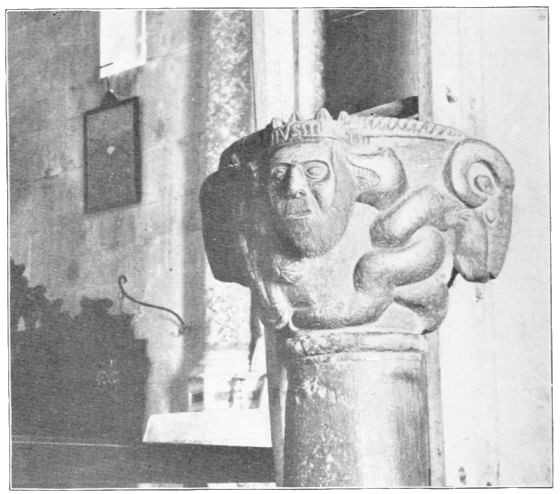
M. M. Newell
HOLY-WATER STOUP, PARISH CHURCH OF S. MARIA E S. GIORGIO
BRANCOLI
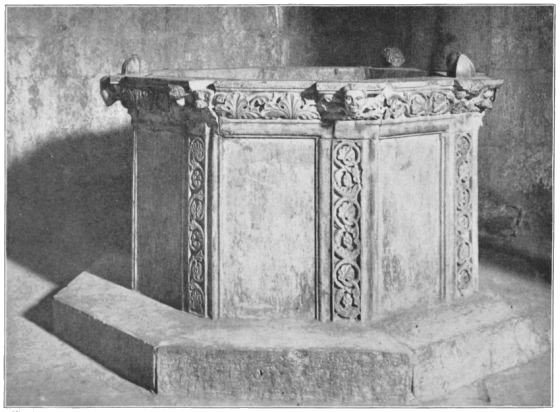
Alinari
HEXAGONAL BAPTISMAL FONT (13TH CENTURY), S. MARIA E S. GIORGIO
BRANCOLI
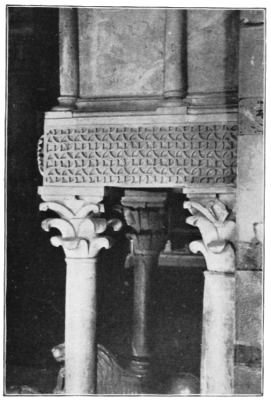
M. M. Newell
DETAIL OF PULPIT, PARISH CHURCH OF S. MARIA
E S. GIORGIO, BRANCOLI

M. M. Newell
DETAIL OF PULPIT, PARISH CHURCH OF BRANCOLI
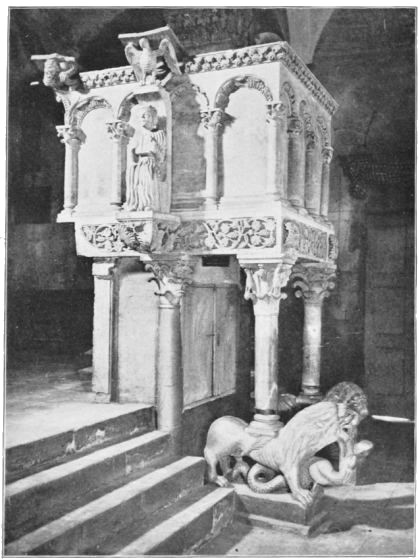
Alinari
PULPIT (13TH CENTURY), S. MARIA E S. GIORGIO, BRANCOLI
Finally, added to its many attractions, the church contains a fine and unusual piece of Della Robbia terra-cotta, the work of Andrea and his son Giovanni. Miss Cruttwell writes: "This romantic scene—I had almost said painting, 'St. George Slaying the Dragon'—is one of the best pictorial works." It is probably the only instance of an attempt by Andrea to represent a horse, and it is undeniably stiff and indifferently[194] modelled. The princess in the background also is rather heavy, but the grace and action of the youthful rider and the beauty and radiance of his expression are remarkable. The frame, probably the work of Giovanni, consists of garlands upheld by winged cherubs, with graceful candelabra and medallions characteristic of the artist.
We left the church of Santa Maria e San Giorgio with regret, but with a sense of complete satisfaction with our day among the hills and temples of Brancoli.
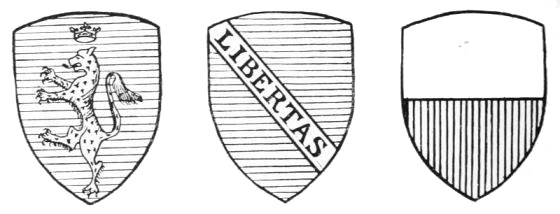
COATS OF ARMS OF LUCCA
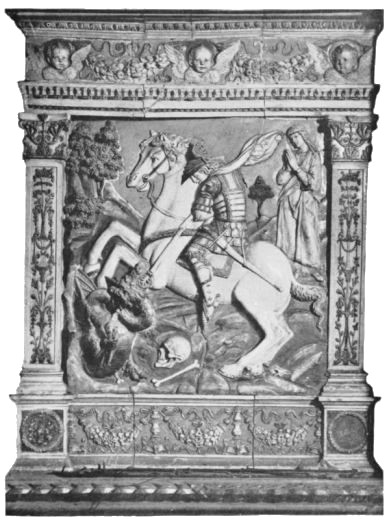
Alinari Andrea and Giov. della Robbia
ST. GEORGE AND THE DRAGON, S. MARIA E S. GIORGIO BRANCOLI
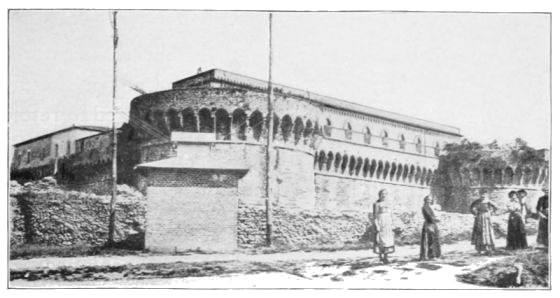
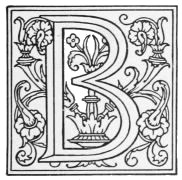 RANCOLI'S HILL commands
a view of the Serchio River and its extensive valley, called the
Garfagnana, which lies between the Apennines, defining the northern
boundary of Tuscany, and the Alpi Apuane range, which follows the
direction of the coast, and contains several lofty peaks, the highest
rising over six thousand feet.
RANCOLI'S HILL commands
a view of the Serchio River and its extensive valley, called the
Garfagnana, which lies between the Apennines, defining the northern
boundary of Tuscany, and the Alpi Apuane range, which follows the
direction of the coast, and contains several lofty peaks, the highest
rising over six thousand feet.
The principal town and capital of the Garfagnana region is Barga, situated thirteen hundred feet above the sea, and containing, we had learned, an interesting[200] church and several pieces of the Della Robbia terra-cotta. As the crow flies it is but a trifling distance over the valley to Barga, but we were obliged to return the way we came and take the main road at San Giusto; a small matter, for in twenty minutes we had dropped down into the valley, passed again the pretty bridge of Vinchiana, also crossed the one over the Serchio, and were speeding along the river bank near the railroad which runs to Bagni di Lucca.
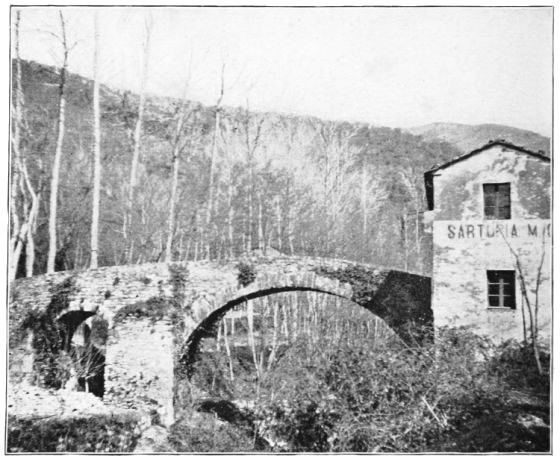
M. M. Newell
THE BRIDGE AT VINCHIANA

Alinari
BORGO A MOZZANO, PONTE DELLA MADDALENA OVER THE SERCHIO, CALLED
"THE DEVIL'S BRIDGE"
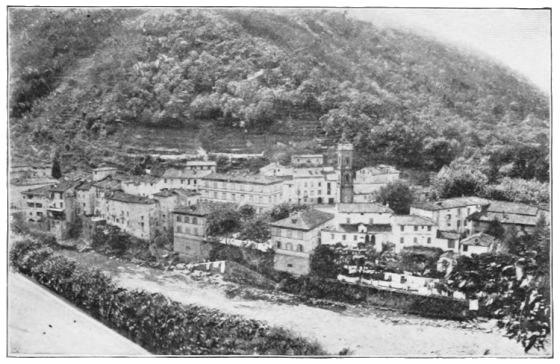
BAGNI DI LUCCA—PANORAMA
At Borgo a Mozzano we see the old bridge, Ponte della Maddalena, oftener called the Devil's Bridge, because traditionally it was built (1328) in one night by Castruccio Castracane, the "greatest war captain of his time." It is a singular structure, very high and narrow, not allowing a carriage of present date to cross, and supported on heavy piers and five arches of irregular height, one of which carries the bridge up, like a camel's hump, rendering it most curious and picturesque. At Ponte a Serraglio is a distant view of Bagni di Lucca, lying in the valley of the Lima.
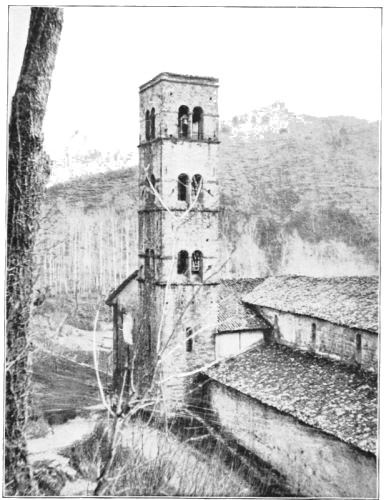
M. M. Newell
PARISH CHURCH, LOPPIA
By this time we have crossed the river, and taken a narrower but equally good highway, though belonging to the second class of carriage roads, every turn of which brings to view new wooded valleys and hilltops crowned with grey villages. In the distance, which is greater than it seems in the clear, luminous atmosphere,[205] we see Ghivizziano's lofty towers, with her train of ruddy roofs and grey walls sharply outlined against the sky. At Fornaci we part company with the Serchio again, strike northward through one of the interesting mountain valleys, and pass close to the ancient parish church of Loppia, weather-beaten and neglected, but none the less a striking landmark and noble monument of mediæval power. Loppia was the capital of the Garfagnana until 1390, when, having been desolated by war and its inhabitants reduced to fifty, its jurisdiction and the title of its parish church were given to Barga, and even its one good picture transferred to the new capital.
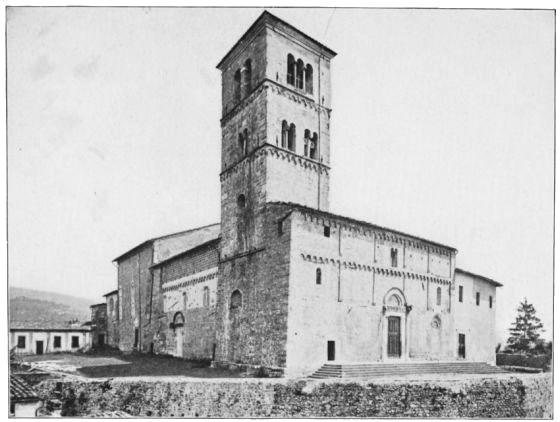
Alinari
THE CATHEDRAL OF BARGA
The whole district is well watered by many mountain streams, affluents of the Serchio, furnishing excellent water-power for various mills scattered along their banks. The soil is generally productive, the uplands covered with chestnut-trees and affording fair pasturage for sheep, which are a source of considerable revenue. On the lower levels we find the olive, maize (or granturco), a principal article of food, and flax, also the mulberry-tree and silk-worm culture. The region is fairly rich in minerals, stone and marble quarries, manganese, mercury, etc. Here, also, is found the fine red jasper, veined or flecked with white, which has been so effectively used in the Medici Chapel in Florence.[208] We are now quite close upon the walls of Barga, but the long drive in the eager, exhilarating mountain air makes us quite willing to take Pepino's advice and stop for lunch at the Posta, an unpretending way[209]side inn, beautifully situated, with plain, comfortable rooms commanding fine views, and where, as a recommendation, we were told a Chicago gentleman had once spent seven weeks for his health. In the words of another visitor, we read that "the soup is excellent, and so is the wine;" also, there is trout when the streams are full. We found everything as had been promised, and did ample justice to the excellent food served by a pretty, smiling contadina, daughter of the house, who was full of chat and little airs, her young head evidently quite turned by her knowledge of the wandering forestieri.

M. M. Newell
MAIN DOOR OF THE CATHEDRAL, BARGA
Hunger appeased and our modest account settled, we walk to the nearest city gate, passing an ample bowling alley, bordered with fine plane-trees. At the upper end is a raised, grassy platform of considerable breadth, in the centre of which stands a fine cedar of Lebanon. The platform is reached by two flights of steps cut into the sod, and tradition has it that here Charlemagne stood and delivered his laws and instructions to the conquered people gathered below. The well-paved street winds and turns up the hill until it terminates in the little plateau, or Piazza del Duomo. The city retains its ancient walls and three old gates, and is still further defended by two deep natural ravines, which render it altogether a striking and typ[210]ical mediæval town. We enter the gate just in time to see a religious procession, consisting apparently of all the people in town, most of the men in capes of green and white, led by three important ecclesiastics in really splendid vestments; two copes were of ivory-white damasked silk, evidently old, adorned with gold; the third, of a peachy-purple tint, enriched also with designs in gold. We join the procession, and wind slowly up the steep path, noting several palaces of old-time importance, and one or two schools or institutions. We see, also, erect and pretty young girls bearing copper pails of water on their heads, lightly mounting the precipitous side streets, and remember then that this mountain region is noted for the beauty of its women. Arriving at the Piazza del Duomo, the procession enters the Church of SS. Christopher and James, to say the prayers appropriate to St. Joseph's day, while we enjoy the wide and beautiful prospect over the Garfagnana valley, held at the north by the hill-town of Fivizzano, surrounded by Castruccio's walls, its church door bearing the Medici shield. On the left, Alpi Apuane, overlooking the charming gulf of Spezia, Carrara, and Sarzana, where Castruccio Castracane built his famous castle, and the only road to which now, as then, is by the castled town of Fosdinovo. To the right are the loftiest peaks of the Apennines:[213] Rondinaio, Monte Prado, Abetone, and the rest, owing "much of their grandeur to the precipitous slopes and fantastic profiles of the calcareous rocks which enter into their composition." The lofty and well-defended position of Barga, near the boundaries of Lucca and Florence, gave it a certain military importance in the early struggles for despotism. At present it is a busy centre of a large district, quiet and orderly, its people marked by spirit, buoyancy of temperament and good looks. To the outside world it is best known for its church, several good Della Robbias, and its fine and beautiful situation. The Church of SS. Christopher and James—is it a temple or a citadel?—built of squared blocks of travertine, unusual and irregular in shape, its watch-tower, or campanile, springing from the main wall and guarding all the country round about, possesses no dominant style of architecture, and wears such an appearance as ten centuries of weather and vicissitudes may well give a church. The grand old tower is fitting, as a human creation may ever hope to be, the prospect it overlooks. Its massive sides are pierced by three orders of double-arched windows, supported by columns and piers, and each order defined by a string course, or corbel-table, of shallow arches, which takes, perhaps, something from the height of the tower, but emphasizes the solidity of its structure. Unlike most towers in this region, it carries no battlements, but is finished by a low, plain roof. The façade of the church is strikingly plain, broken only by a single cornice, string course, and short pilasters. The main door alone retains a hint of former grandeur in its foliated arch and sculptured architrave, once guarded by two Lombardic lions, one of which has fallen from its high estate. The front and side walls are pierced irregularly with small windows of varied shape and size.

Alinari
INTERIOR OF THE CATHEDRAL OF BARGA
The interior is plain, resembling an ancient basilica in form, and divided into nave and aisles by piers supporting broad, semi-circular arches, and over all a good, open-timbered roof. The tribune, or choir, is raised above the nave by three steps, and separated from it by a low marble screen or parapetto. An ancient-looking holy-water stoup, carved with rude heads and designs, stands by a pillar on the north side of the nave, but the great treasures of the church are its choir-screen and pulpit. The screen consists of panels of pale red marble delicately veined, set in frames, or borders, of white Carrara, inlaid with black smalto, or enamel, in various designs and symbolic geometrical figures. That part of the screen near the pulpit is further enriched by a row of small, well-modelled heads, some of which, evidently portraits, are encircled by[215] crowns. The pulpit must certainly be reckoned among the best ones in Tuscany; its author is unknown, but it probably belongs to the thirteenth century, about the time of the Pisani, possibly earlier. The richness of detail, dignity and expression of the rather stiff figures, suggest the work of Guido da Como.

Alinari
PULPIT (13th CENTURY)
IN THE CATHEDRAL OF BARGA
The pulpit is rectangular, and supported on four marble columns, two of which rest on the backs of lions, overcoming symbolic forms of evil. Another rests on the shoulders of a man, perhaps the artist, and all the capitals are elaborately sculptured in varying designs, one bearing the forms of eagles and animals' heads.
On the panels of the pulpit are the sculptured scenes of the Annunciation, the Nativity, and Adoration of the Magi, treated in the usual manner. On the central plinth of the front appears a crowned figure holding the Book of Good Tidings, and supported by the appropriate symbolic animals; above this figure the eagle upholds a lectern. The figures are carved in strong relief, and though the feet and hands are stiff, the faces are serious and fairly modelled, and the drapery well disposed. Heavy as the work is, we are conscious that the artist, a man of the long ago past, was himself impressed by his subject, and put into his realistic interpretation of it a profound religious mysticism.[218] The whole work is enriched by inlaying of black marble, or smalto, with the white. Crowns, the lions' manes, and coils of the writhing serpent are picked out with black, an early form of decoration.
In the choir aisle is a beautiful tabernacle for the sacred oil, of glazed terra-cotta, chiefly white on blue, the work of the Della Robbia school or atelier. Though small, the work is composed of three perfect parts. On the arched top is a charming group of infantile figures, the Christ child standing upright on the Holy Chalice, one tiny hand uplifted in blessing, the other holding the crown of thorns; on either side is an adoring cherub, exquisitely modelled. Below this is the cupboard, or ciborium, for the oil, guarded by two graceful angel forms, and on each side an acolyte bearing a candelabrum. The whole work rests on a table, or ledge, supported by two cornucopiæ of various fruits in natural colors, and between them appears the head of a cherub enfolded in double wings.

Alinari
ADORATION OF THE MAGI (13TH CENTURY)
PULPIT IN THE CATHEDRAL OF BARGA
Well might this fortress-temple detain us longer, but there is scant time to have a look at the other Della Robbias down in the heart of the town, to which we are conducted by a courteous and handsome little man of twelve, through the narrowest and steepest of byways, which threaten at times to plunge us into doorways or ditches, until we reach the Church of the Capuchins. This contains a Nativity, two good statues of St. Andrew and St. Anthony, an Annunciation, St. Francis receiving the Stigmata, and, finest of all, an Assumption of the Virgin, by Giovanni Della Robbia. The reverent figures of four saints gaze upward to Our Lady, seated within a mandorla of cherubs' heads and surrounded by angels with musical instruments; the four trumpeters at the top are most beautiful. In the predella are other flying angels with scrolls; a wreath of exquisite heads surround the ciborium, and two kneeling saints fill the corners. The whole work is framed with clusters of various fruits in their natural colours.
Reluctantly we turn from rock-throned Barga, "Half church of God, half castle 'gainst the Scot," and as we slip down into the valley through purpling shadows shot with crimson and gold we marvel at these people, who with one hand took their part fiercely in the cruel wars of despotism and with the other adorned churches and shrines with Della Robbia reliefs, representing a form of art so pure and cool and tranquil and, above all, infused with the deepest religious feeling. Then we suddenly remember that hereabouts is the region of the Pistojese Apennines, the favoured home of the highest Tuscan imagination, poetry and song, where the people—peasants, shepherds, and mountaineers—are not only hardy, handsome, and industrious as a[222] class, but noted for gentleness and courtesy, love of home, and the native elegance of their common speech. It is said that "the dialect that most faithfully represents the pure Tuscan of Boccaccio's day is that of peasants of the Pistojese Apennines. It is here, round about San Marcello and Cutigliano, that the purest Tuscan is spoken—pure in its language, pure in its accent; and it is here that Manzoni and d'Azelio came—comparative foreigners both of them, the one a Lombard, the other a Piedmontese—to acquire the pure language for those romances which have delighted all Italy and all the world."[10]
It is in the Pistojese mountains that we hear those "charming folk songs, in which traditions of true gentleness and elevated feeling are so well exhibited, and account for the high romantic qualities of the impassioned verse."[11]
Shepherds often improvise songs, called rispetti and stornelli, as they tend their flocks alone on the hills, and if their cadence chance to catch the popular ear they are sown on a hundred hills and meadows far and wide. Tigri records by name a little girl called Cherubina who made rispetti by the dozen as she watched[223] her sheep, and the poetry of Beatrice di Pian degli Ontani was famous through the mountains of Pistoja.[12]

Alinari Della Robbia School
TABERNACLE FOR SACRED OIL
CATHEDRAL, BARGA
Miss Alexander, in her "Road Songs of Tuscany," has given an appreciative and loving tribute to this pastoral singer, whom she calls "one of the most wonderful women" she ever saw. The daughter of a stone-mason who worked during the winter in the Maremma, Beatrice became his companion and helper, carrying on her head stones for the walls and bridges he was building. She had no education, never learning the alphabet even, but possessed a remarkable memory, and could recite long poems that she had heard.
YOU ASK ME FOR A SONG
It was not till the day of her marriage that Beatrice discovered her new power "to sing poetry born in her mind," and from that day she never lost her remarkable[226] power of improvisation, and the list of her ballads is very long and varied in theme. She had a strong religious nature, and addressed many of her songs to the Madonna. In her old age, it is said, she knew in poetic form nearly all the New Testament and much of the Old.

Alinari Giovanni della Robbia
ASSUMPTION OF THE VIRGIN
CHURCH OF THE CAPUCHINS, BARGA
GIVE ME LIGHT, LADY
Her eldest son inherited her poetic gift, and often when working in the fields mother and son would carry on a conversation in improvised verse, Beatrice singing one ottava, Beppo answering with another. Miss Alexander says that as a girl Beatrice was very handsome, with an inspired face, charming smile, and sympathetic voice. She had great physical strength and indomitable courage. She generally wore her contadina dress of scarlet bodice, blue kerchief, garnet necklace, and gold earrings. On grand occasions she put on a white embroidered veil, kerchief, and apron belonging[227] to her wedding finery. Beatrice lived over a hundred years, "much loved and honoured by her neighbours and all who knew her," and many pleasant anecdotes are told of her experiences and talent. A Boston lady told us that once, when Madame Goldschmidt (better known as Jenny Lind, or the "Swedish Nightingale,") was visiting friends in the Apennines, a meeting was arranged between the two singers, both elderly women at the time. First Beatrice, in her peasant dress, sang to the great prima-donna of the North, improvising words and music suitable to the occasion. In return Madame Goldschmidt, much gratified, sang one of the songs which has so often moved her great audiences to rapturous applause.[13]

M. M. Newell
"VIOLET-EYED TUSCAN OXEN"
THE DOVE

DETAIL OF TRAPPINGS ON THE HORSE OF LORENZO DE' MEDICI
[1] E. Armstrong, M.A., Lorenzo de' Medici, p. 437. B. Berenson, The Study and Criticism of Italian Art. Second series. "A Word for Renaissance Churches."
[2] The quarries of serpentine (verde di Prato) near Prato have been worked from a very early period. Their present output is valued at £1,000 per annum.—From The British Diplomatic and Consular Report, No. 570, 1901.
[3] References Consular Report on Commerce and Manufacture in Italy, vol. xlv. The Nation, No. 1105. E. S. Morgan, Time, vol. xiv.
[4] See Cruttwell's Luca and Andrea Della Robbia, chapter vii.
[5] Francis A. Hyett, B.A., Florence, p. 104.
[6] J. A. Symonds, Age of Despots, p. 87.
[7] Francis A. Hyett, B.A., Florence, p. 106.
[8] See Symonds' Essay in Sketches and Studies, vol. i., p. 173.
[9] Francis A. Hyett, B.A., Florence, p. 99.
[10] M. Carmichael, In Tuscany, p. 102.
[11] J. A. Symonds, "Popular Songs in Tuscany," Sketches and Studies, vol. ii.
[12] John Ruskin, ed., Alexander's Road Songs of Tuscany (1884).
[13] Alessandro Chiappelli, Una Pastora Poetessa, Beatrice di Pian degli Ontani (Florence, 1902).
Transcriber Notes:
P. 56. Illustration is probably 'GARDEN BELONGING TO LORENZO'S VILLA POGGIO A CAIANO', not changed.
P. 115. Illustration--Madonna and Child, with two Saints, "Alinar'" changed to "Alinari".
P. 233. 'Cancelliere' changed to 'Cancellieri'.
P. 237. 'Galleazzo' changed to 'Galeazzo'.